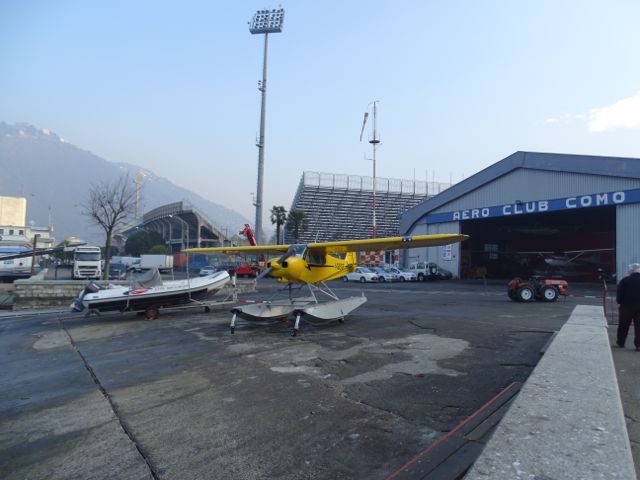Greece 2016
We must first of all apologise for the delay in updating the site. Just before Christmas our Big Mac (17” MacBook Pro) decided not to work. One minute it was fine, then nothing at all. We tried a restart and our screen was covered in nice pink and white stripes... lovely. The saga of the repair can be found below.
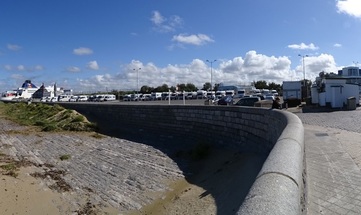 Calais Aire. Frites Hut bottom right.
Calais Aire. Frites Hut bottom right.
Birthday Start
After a lovely time in the UK visiting family and friends we decided that it was time to move somewhere warmer. Our start date was Ian’s Birthday, 30 November.
It happened to be the day that there was a strong wind on the Channel. According to the Captain we had 55 mph gusts which probably accounted for the delay in departing. But the crossing was lovely on the Spirit of Britain. She had recently had a refit and was in pristine condition.
On arrival we drove direct to the Aire in Calais and had no problems with illegal immigrants. They generally attack vehicles heading FOR the UK.
Once again we took advantage of the Frites Shops on the seafront and had a very tasty and warming plate of frites and frikandel (sausage).
After a lovely time in the UK visiting family and friends we decided that it was time to move somewhere warmer. Our start date was Ian’s Birthday, 30 November.
It happened to be the day that there was a strong wind on the Channel. According to the Captain we had 55 mph gusts which probably accounted for the delay in departing. But the crossing was lovely on the Spirit of Britain. She had recently had a refit and was in pristine condition.
On arrival we drove direct to the Aire in Calais and had no problems with illegal immigrants. They generally attack vehicles heading FOR the UK.
Once again we took advantage of the Frites Shops on the seafront and had a very tasty and warming plate of frites and frikandel (sausage).
Head South
In the morning our first call was to Auchan in Grande-Synthe to buy our Christmas dinner and some diesel. The dinner was Confit of Duck. It is absolutely divine.
From there it was south past Armentieres, where the WWI song came from, through Lille and Valenciennes, Louvroil, Avesnes-sur-Helpe and Hirson. There we turned East towards Belgium; through Charleville-Mezieres and Sedan. The weather was getting foggy by now and quite cold.
After Sedan we turned North to enter Belgium via the Ardennes. Interestingly, after all the troubles in Paris, we saw no border controls between France and Belgium. By tea time we were in our usual Aire behind the fire station at Arlon. We were lucky and nabbed the last electric hookup. It was 9°C when we arrived.
After a cool night we drove into Luxembourg for cheap diesel and tobacco.
Why is it that the people of Luxembourg seem to pay no taxes, have cheap booze, fuel and tobacco and contribute 75 Euro per person over what they receive from the EU?
In the UK we pay high taxes and contribute 118 Euro per person over what we receive from the EU. Is something wrong here... you decide?
Leaving Luxembourg and heading south into France again we were held up on the motorway by the Police. They were checking all the vehicles heading into, and out of, France. That added two hours to the journey.
Finally past the hold up we passed Metz and Nancy (where Renee the Nancy Boy came from). After a long day in fog and mist we arrived at an Aire we tried earlier in the year at Ferrette. The facilities were switched off but that was no problem and we had a peaceful night.
In the morning our first call was to Auchan in Grande-Synthe to buy our Christmas dinner and some diesel. The dinner was Confit of Duck. It is absolutely divine.
From there it was south past Armentieres, where the WWI song came from, through Lille and Valenciennes, Louvroil, Avesnes-sur-Helpe and Hirson. There we turned East towards Belgium; through Charleville-Mezieres and Sedan. The weather was getting foggy by now and quite cold.
After Sedan we turned North to enter Belgium via the Ardennes. Interestingly, after all the troubles in Paris, we saw no border controls between France and Belgium. By tea time we were in our usual Aire behind the fire station at Arlon. We were lucky and nabbed the last electric hookup. It was 9°C when we arrived.
After a cool night we drove into Luxembourg for cheap diesel and tobacco.
Why is it that the people of Luxembourg seem to pay no taxes, have cheap booze, fuel and tobacco and contribute 75 Euro per person over what they receive from the EU?
In the UK we pay high taxes and contribute 118 Euro per person over what we receive from the EU. Is something wrong here... you decide?
Leaving Luxembourg and heading south into France again we were held up on the motorway by the Police. They were checking all the vehicles heading into, and out of, France. That added two hours to the journey.
Finally past the hold up we passed Metz and Nancy (where Renee the Nancy Boy came from). After a long day in fog and mist we arrived at an Aire we tried earlier in the year at Ferrette. The facilities were switched off but that was no problem and we had a peaceful night.
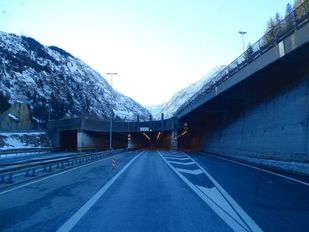 St Gottard tunnel entrance. 17 km to go.
St Gottard tunnel entrance. 17 km to go.
Where is Switzerland?
In the morning we drove to Switzerland; entering at Basel. We did not have to pay a toll because we still had several days on our annual 10-day ticket.
Switzerland is very scenic but not today. We had the fog and low cloud again and our view was limited to the autobahn. There was not much point in stopping so we drove straight through and went to Como in Northern Italy. We had heard of a stopping place and finally found it right next to the lake and alongside the Aero Club of Como.
We had time to have a walkabout and look at the villas, but Ian was more interested in watching the float planes taking off and landing on the lake. Meanwhile Judit walked around the old city, looking at ice skaters, Christmas stalls and the usual narrow streets around the big church.
During the day the weather was mild but very cold at night.
No LPG
Another foggy day. Como is very nice but a bit of a one-way street maze. Finally we hit the autostrada and were driving past Milan. Then it was a long run past Parma, Modena and Bologna until we hit the East coast of Italy near Rimini. There we had some sunshine at last.
The drive on the Adriatic coast was pleasant but we were not allowed to buy LPG on the autostrada. We tried three different filling stations and they all said it was not allowed, by law, to buy LPG for the “kitchen” only for the “engine”. We stopped at a Night Stop near Fermo and had a lovely night almost on the beach.
Another foggy day. Como is very nice but a bit of a one-way street maze. Finally we hit the autostrada and were driving past Milan. Then it was a long run past Parma, Modena and Bologna until we hit the East coast of Italy near Rimini. There we had some sunshine at last.
The drive on the Adriatic coast was pleasant but we were not allowed to buy LPG on the autostrada. We tried three different filling stations and they all said it was not allowed, by law, to buy LPG for the “kitchen” only for the “engine”. We stopped at a Night Stop near Fermo and had a lovely night almost on the beach.
Yes there is...
By now we were getting a bit low on gas because we’ve been using it for heating as well as cooking. That really gobbles up the gas. Therefore we stayed off the motorway for a while and found a small filling station where we filled up with diesel and LPG... good man. I don’t think he was interested in the law.
We even had a stop in LIDL. Italians pay about €7.00 for a bottle of whisky. We pay about £15.00 (about €19.50) for similar in the UK. One has to ask why are we paying massive taxes in the UK so Italians can have cheap whisky!
Anyway, with 2 or 3 bottles in the locker we drove on to Bari, parked in the harbour and booked a ferry for Sunday as it is a daytime crossing.
Interestingly we were testing our new SatNav so we followed Jane’s directions to the letter and arrived at the dock gates. The porter chappy made us go to another entrance where we then followed the road back past the original dock gate. So we drove and extra 5 kilometers so that we could wave to the porter twice. You can’t beat an Italian jobsworth.
By now we were getting a bit low on gas because we’ve been using it for heating as well as cooking. That really gobbles up the gas. Therefore we stayed off the motorway for a while and found a small filling station where we filled up with diesel and LPG... good man. I don’t think he was interested in the law.
We even had a stop in LIDL. Italians pay about €7.00 for a bottle of whisky. We pay about £15.00 (about €19.50) for similar in the UK. One has to ask why are we paying massive taxes in the UK so Italians can have cheap whisky!
Anyway, with 2 or 3 bottles in the locker we drove on to Bari, parked in the harbour and booked a ferry for Sunday as it is a daytime crossing.
Interestingly we were testing our new SatNav so we followed Jane’s directions to the letter and arrived at the dock gates. The porter chappy made us go to another entrance where we then followed the road back past the original dock gate. So we drove and extra 5 kilometers so that we could wave to the porter twice. You can’t beat an Italian jobsworth.
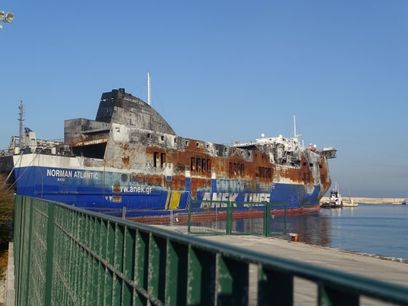 Wreck of the Norman Atlantic, Bari Port
Wreck of the Norman Atlantic, Bari Port
Off putting
On 28 December 2014, the ferry Norman Atlantic caught fire in the Adriatic Sea on route from Patras to Ancona. The bodies of nine victims were recovered from the sea, while nineteen others remain missing. Additionally, two crew members of the Albanian tug Iliria were killed during the salvage operations on 30 December. According to ANEK Lines, the total number of passengers and crew, based on the ship's manifest, was 475. As of 31 December, reports indicated that 499 people were on board the ferry, including 55 crew members; this figure excludes possible stowaways who were on board.
Within 100 yards of our parking place was the wreck of the Norman Atlantic. The bow doors were open and inside we could see several vehicles including a motorhome. Leaving the wreck so close to the other ferry departure dock is possibly not the best PR !
Our departure on Sunday 6 December 2015 was the usual shambles. The problem is that the ferries only have doors at the stern. That means every vehicle has to turn round ready for the disembarking. It goes without saying that it is not easy or quick for a truck with a trailer.
The good thing was that the ship was really pleasant on board. In fact, on a par with the Cross Channel ferries.
Disembarking at 23-30 in Igoumenitsa was simple and quick and within 20 minutes we were in our favoured spot at Drepano Beach.
On 28 December 2014, the ferry Norman Atlantic caught fire in the Adriatic Sea on route from Patras to Ancona. The bodies of nine victims were recovered from the sea, while nineteen others remain missing. Additionally, two crew members of the Albanian tug Iliria were killed during the salvage operations on 30 December. According to ANEK Lines, the total number of passengers and crew, based on the ship's manifest, was 475. As of 31 December, reports indicated that 499 people were on board the ferry, including 55 crew members; this figure excludes possible stowaways who were on board.
Within 100 yards of our parking place was the wreck of the Norman Atlantic. The bow doors were open and inside we could see several vehicles including a motorhome. Leaving the wreck so close to the other ferry departure dock is possibly not the best PR !
Our departure on Sunday 6 December 2015 was the usual shambles. The problem is that the ferries only have doors at the stern. That means every vehicle has to turn round ready for the disembarking. It goes without saying that it is not easy or quick for a truck with a trailer.
The good thing was that the ship was really pleasant on board. In fact, on a par with the Cross Channel ferries.
Disembarking at 23-30 in Igoumenitsa was simple and quick and within 20 minutes we were in our favoured spot at Drepano Beach.
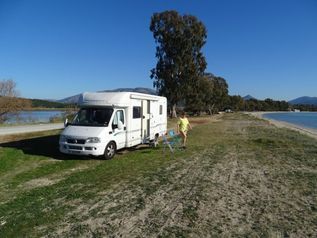 Judit heads for a paddle at Igoumenitsa.
Judit heads for a paddle at Igoumenitsa.
Rest day
The weather was fine and warm so we decided to stay a day here and enjoy the scenery. But first we had to go into town and find an ATM as we were running low on cash.
Back on the beach we were soon joined by a few stray dogs. What a shame. We hear that a lot of Greeks have so little money they cannot cater for their dogs and let them free.
During the night we had a shock. At 02-00 we were woken by some idiot banging on the side of the motorhome. Being a big brave boy, Ian decided that the best action to take was to do nothing. We never heard any footsteps or talking so went back to sleep.
It’s rather strange because there is no passing traffic on the beach road; it goes nowhere and is about 6 Km from the town. Did some local lout walk all this way at 02-00 to bang on our motorhome? Anyway, this is the first disturbing event since we started motorhoming. We are not deterred.
The weather was fine and warm so we decided to stay a day here and enjoy the scenery. But first we had to go into town and find an ATM as we were running low on cash.
Back on the beach we were soon joined by a few stray dogs. What a shame. We hear that a lot of Greeks have so little money they cannot cater for their dogs and let them free.
During the night we had a shock. At 02-00 we were woken by some idiot banging on the side of the motorhome. Being a big brave boy, Ian decided that the best action to take was to do nothing. We never heard any footsteps or talking so went back to sleep.
It’s rather strange because there is no passing traffic on the beach road; it goes nowhere and is about 6 Km from the town. Did some local lout walk all this way at 02-00 to bang on our motorhome? Anyway, this is the first disturbing event since we started motorhoming. We are not deterred.
No motorhomes
Lovely bright morning for a long drive. Quite simple really, just take the motorway towards Thessaloniki and then the first exit to head south. Luckily we stopped to fill up at Mazarakia as we didn’t see another filling station for quite a while.
We drove past Mesopotamus which is a lovely name... meso means between and potamos means rivers. The next key point was Preveza where there is an “Underwater Crossing” or tunnel as we know it.
We took the road to Amfilochia where it meets the main road from Ioannina to the south. Driving was much easier after that.
Then came the Rio-Antirrio Bridge. What a majestic sight, but it cost €13.20 to cross one way. Maybe I should stop moaning about the stupid Dart Crossing.
Finally we were approaching Pyrgos and the turning for Katakolo. For some reason this area seems to be a giant rubbish dump. At almost every road junction rubbish bags were piled high and would stretch some 50 to 100 meters. We’ve seen this several times near Pyrgos. Do they only collect rubbish every 2 months? What’s going on?
The plan was to go to the harbour and park there for the night. At the entrance was a large sign, about one meter square, stating, “No Camping, No Motorhomes”. So we went in and hooked up to the electric point and had a lovely quiet night.
Last summer the place was throbbing with tourists from cruise ships and now every business was closed except one. That’s where we went for dinner. It was pleasant and the young lad serving was pleasant, but it felt like we were in the early scenes from a horror movie... where is everybody?
Lovely bright morning for a long drive. Quite simple really, just take the motorway towards Thessaloniki and then the first exit to head south. Luckily we stopped to fill up at Mazarakia as we didn’t see another filling station for quite a while.
We drove past Mesopotamus which is a lovely name... meso means between and potamos means rivers. The next key point was Preveza where there is an “Underwater Crossing” or tunnel as we know it.
We took the road to Amfilochia where it meets the main road from Ioannina to the south. Driving was much easier after that.
Then came the Rio-Antirrio Bridge. What a majestic sight, but it cost €13.20 to cross one way. Maybe I should stop moaning about the stupid Dart Crossing.
Finally we were approaching Pyrgos and the turning for Katakolo. For some reason this area seems to be a giant rubbish dump. At almost every road junction rubbish bags were piled high and would stretch some 50 to 100 meters. We’ve seen this several times near Pyrgos. Do they only collect rubbish every 2 months? What’s going on?
The plan was to go to the harbour and park there for the night. At the entrance was a large sign, about one meter square, stating, “No Camping, No Motorhomes”. So we went in and hooked up to the electric point and had a lovely quiet night.
Last summer the place was throbbing with tourists from cruise ships and now every business was closed except one. That’s where we went for dinner. It was pleasant and the young lad serving was pleasant, but it felt like we were in the early scenes from a horror movie... where is everybody?
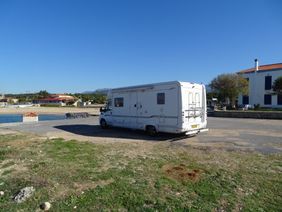 Agios Kiriaki would be a good Night Stop
Agios Kiriaki would be a good Night Stop
We should stay here
Back to the main road and head south again. From this area the road seems to lose its pride and becomes progressively narrower and more winding as it approaches Pylos. But this is rather pleasant of course and the weather was lovely. We drove through a small village called Zacharo which Google translates as “diabetes”. Then we passed Kalo Nero, which translates as “Good Water”.
The place we always say we should stop at is Agios Kiriaki. It’s a lovely small village with a small harbour. There is a decent car park and nice views. But we never do stop for the night; it’s probably too close to our destination. Shame really. But to show we like the place we stopped for our lunch and the locals all greeted us in a kindly manner.
Back to the main road and head south again. From this area the road seems to lose its pride and becomes progressively narrower and more winding as it approaches Pylos. But this is rather pleasant of course and the weather was lovely. We drove through a small village called Zacharo which Google translates as “diabetes”. Then we passed Kalo Nero, which translates as “Good Water”.
The place we always say we should stop at is Agios Kiriaki. It’s a lovely small village with a small harbour. There is a decent car park and nice views. But we never do stop for the night; it’s probably too close to our destination. Shame really. But to show we like the place we stopped for our lunch and the locals all greeted us in a kindly manner.
Just after the village of Rikia is a very twisty section of road with olive branches threatening to do evil things to the motorhome. There is clearly a plan to build a bypass but it’s only got as far as putting down the hardcore. It looks tempting and the locals use it, but we don’t fancy loose stones bouncing around under Bessy. So, instead we follow the old road and pass through Tragana which translates as “Crunchy”.
It’s not far from there to Navarino Bay and the “90° left at Gialova”. We call it that because everyone seems to know the corner. From that corner the road originally followed the coast to Pylos but some rich person built a golf course and had the road diverted to an older road. Now the old road has started to collapse.
The plus point is fantastic views over the bay.
It’s not far from there to Navarino Bay and the “90° left at Gialova”. We call it that because everyone seems to know the corner. From that corner the road originally followed the coast to Pylos but some rich person built a golf course and had the road diverted to an older road. Now the old road has started to collapse.
The plus point is fantastic views over the bay.
A bit of history
The Battle of Navarino was a naval battle fought on 20 October 1827, during the Greek War of Independence (1821–32), in Navarino Bay.
A Turkish armada, which, included squadrons from Egypt, Tunis and Algiers, was destroyed by an Allied force of British, French and Russian vessels. It was the last major naval battle in history to be fought entirely with sailing ships, although most ships fought at anchor. The Allies' victory was achieved through superior firepower and gunnery.
The naval battle happened more by accident than by design as a result of a maneuver by the Allied commander-in-chief, Admiral Edward Codrington, aimed at coercing the Ottoman commander to obey Allied instructions.
The sinking of the Ottomans' Mediterranean fleet saved the fledgling Greek Republic from collapse.
The Battle of Navarino was a naval battle fought on 20 October 1827, during the Greek War of Independence (1821–32), in Navarino Bay.
A Turkish armada, which, included squadrons from Egypt, Tunis and Algiers, was destroyed by an Allied force of British, French and Russian vessels. It was the last major naval battle in history to be fought entirely with sailing ships, although most ships fought at anchor. The Allies' victory was achieved through superior firepower and gunnery.
The naval battle happened more by accident than by design as a result of a maneuver by the Allied commander-in-chief, Admiral Edward Codrington, aimed at coercing the Ottoman commander to obey Allied instructions.
The sinking of the Ottomans' Mediterranean fleet saved the fledgling Greek Republic from collapse.
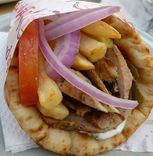 Delicious Greek gyros
Delicious Greek gyros
Irresistable
From here it’s almost like being home again. For some reason the powers that be are digging up half the town, presumably to improve it. It seemed perfectly OK to us... maybe they had some EU money to use up. We walked past the rubble and did a bit of shopping and ate a gyros.
It is not permitted to visit Pylos without eating a gyros. The local fast food joint makes a great gyros. Imagine the typical kebab shop. Take slices off the meat and put it on a Greek flat bread that has been smeared with lashings of tzatziki. Add tomatoes, sliced onions and some chips and roll it to a cone. In fact gyro means “turn”. Enjoy it for only €2.00.
From here it’s almost like being home again. For some reason the powers that be are digging up half the town, presumably to improve it. It seemed perfectly OK to us... maybe they had some EU money to use up. We walked past the rubble and did a bit of shopping and ate a gyros.
It is not permitted to visit Pylos without eating a gyros. The local fast food joint makes a great gyros. Imagine the typical kebab shop. Take slices off the meat and put it on a Greek flat bread that has been smeared with lashings of tzatziki. Add tomatoes, sliced onions and some chips and roll it to a cone. In fact gyro means “turn”. Enjoy it for only €2.00.
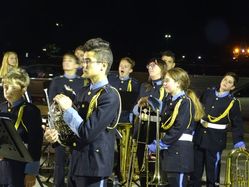 The band has a break at the Christmas Tree illumination
The band has a break at the Christmas Tree illumination
Enough of that. Back to the road and we are on the home run. Pass Methoni with it’s fantastic castle and restaurants and within another 7 km we arrive at Camping Finikes. There were our old friends, Albert and Gabi, Erika and Hans, an Italian couple and a Swedish couple and our old English friend who shall be nameless... but I think he knows his own name!
It was also great to see our friends Rose and Alf. Rose was playing her trombone in Pylos where they were erecting the Christmas tree. Afterwards we enjoyed a good meal in Kastro Taverna in Methoni.
It was also great to see our friends Rose and Alf. Rose was playing her trombone in Pylos where they were erecting the Christmas tree. Afterwards we enjoyed a good meal in Kastro Taverna in Methoni.
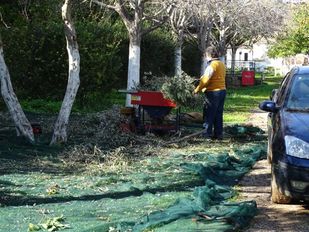 Picking olives in the camp
Picking olives in the camp
We had a minor catastrophe one day when the fan heater caught fire. Luckily it was near the door and a good boot solved that problem. Naturally, with it being cool in the evenings we had to go to Pylos to buy another heater.
On the run up to Christmas we went to the local olive press and bought four tins of olive oil. That should keep us going.
Another outing with Rose and Alf was to a concert in a Pylos hotel. The band was playing again and they had a great rendition of “Sousa Meets Santa”. After the show we enjoyed a couple of beers in the “pub” in Methoni.
After Christmas we were taken out again to Evaggelismos (or Evengelismos) where a Pakistani man was cooking “indian” food. It was really a mix of Greek and Asian but very tasty and a lot of Brits, Dutch and Germans had turned out for a really jolly evening.
We are very grateful to Rose and Alf for shipping us around in her terrier-like Lada Niva.
On the run up to Christmas we went to the local olive press and bought four tins of olive oil. That should keep us going.
Another outing with Rose and Alf was to a concert in a Pylos hotel. The band was playing again and they had a great rendition of “Sousa Meets Santa”. After the show we enjoyed a couple of beers in the “pub” in Methoni.
After Christmas we were taken out again to Evaggelismos (or Evengelismos) where a Pakistani man was cooking “indian” food. It was really a mix of Greek and Asian but very tasty and a lot of Brits, Dutch and Germans had turned out for a really jolly evening.
We are very grateful to Rose and Alf for shipping us around in her terrier-like Lada Niva.
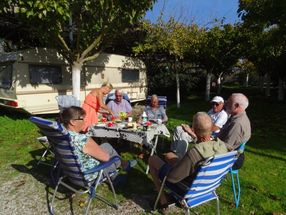 Christmas day coffee morning
Christmas day coffee morning
Christmas
Hot sunny day and a communal natter and a coffee with Oscar keeping an eye on everything.
Who is Oscar? He is a lovely English Pointer stray that has adopted everyone at the campsite. He is very elegant and loves to play and eat. His favourite game is to run around on the dunes looking for mice and lizards. He is capable of digging so deep that he is up to his shoulders in the hole before emerging with a head covered in sand.
Naturally we had a great Christmas meal with Confit of Duck and the usual Christmas trimmings... excellent.
Hot sunny day and a communal natter and a coffee with Oscar keeping an eye on everything.
Who is Oscar? He is a lovely English Pointer stray that has adopted everyone at the campsite. He is very elegant and loves to play and eat. His favourite game is to run around on the dunes looking for mice and lizards. He is capable of digging so deep that he is up to his shoulders in the hole before emerging with a head covered in sand.
Naturally we had a great Christmas meal with Confit of Duck and the usual Christmas trimmings... excellent.
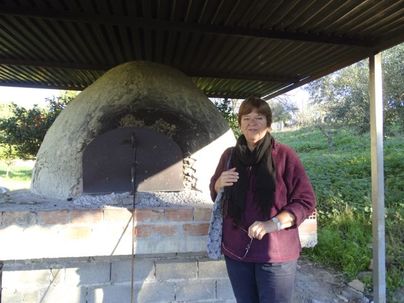 Judit waiting for the bread to bake.
Judit waiting for the bread to bake.
Bread
Every Friday the ladies of the camp walked a few hundred meters to a field. A local lady had built a traditional wood fired oven in an olive grove. She made sourdough bread to order at €5.00 a loaf. It was very interesting and very romantic.
Ian and Albert called it "concrete bread" because the crust was so thick and hard.
Oscar enjoyed the crusts.
Every Friday the ladies of the camp walked a few hundred meters to a field. A local lady had built a traditional wood fired oven in an olive grove. She made sourdough bread to order at €5.00 a loaf. It was very interesting and very romantic.
Ian and Albert called it "concrete bread" because the crust was so thick and hard.
Oscar enjoyed the crusts.
Electricity
Are we being punished for some sin we have committed? First the fan heater, then the electric kettle and the ultimate horror... the Mac died on us. So started a saga. First to Kalamata to do a bit of “LIDL-ing” and then to IDEA shop for a kettle. As soon as we arrived home we found that the base of the electric kettle was cracked.
Back to Kalamata for another; and then that decided not to work. But a bit of fiddling around soon sorted that.
Are we being punished for some sin we have committed? First the fan heater, then the electric kettle and the ultimate horror... the Mac died on us. So started a saga. First to Kalamata to do a bit of “LIDL-ing” and then to IDEA shop for a kettle. As soon as we arrived home we found that the base of the electric kettle was cracked.
Back to Kalamata for another; and then that decided not to work. But a bit of fiddling around soon sorted that.
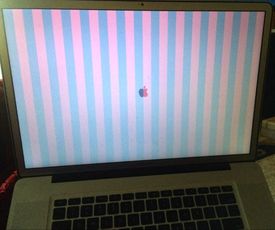 This means the video board is faulty!
This means the video board is faulty!
But the Mac was another problem. A SKYPE call to UK Apple was transferred to California where a good guy found our nearest Mac Service and told us that the fault with the video card would be repaired for free. The nearest service is in Glyfada which is near Athens.
Ian called them and they said to send the Mac by courier and it would take 2 or 3 days. Off we went to Pylos (again) to find ACS courier service. Their website had a map for the Pylos office. But they clearly do not update the website and we found that the office had moved. Once found they told us they do not have boxes. That started a grand tour of Pylos begging at shops for a box. The man in the computer shop gave us a few meters of bubble wrap and the man in Euronics gave us part of a box. So back to Bessy to find some more cardboard and convert the part box into a full one. Then back to ACS. They told us the Mac would be delivered in the morning. Yippee.
However their Track and Trace system on the internet did not work and it took four days to arrive in Glyfada. In keeping with the story of our bad fortune, New Year got in the way. Then Epiphany followed by “a big names day”. After over a week in the service they sent the Mac back. Once again Track and Trace did not work and we had to call their head office again. Luckily by this time our friends from Athens, Sue and Craig, had arrived in camp and they spoke Greek. After several calls we found that the Mac was actually on its way to us. Sure enough it arrived 2 hours later. Yippee. Interestingly, the cost to send to Glyfada was €20.00. The cost from Glyfada was €29.00.
Ian called them and they said to send the Mac by courier and it would take 2 or 3 days. Off we went to Pylos (again) to find ACS courier service. Their website had a map for the Pylos office. But they clearly do not update the website and we found that the office had moved. Once found they told us they do not have boxes. That started a grand tour of Pylos begging at shops for a box. The man in the computer shop gave us a few meters of bubble wrap and the man in Euronics gave us part of a box. So back to Bessy to find some more cardboard and convert the part box into a full one. Then back to ACS. They told us the Mac would be delivered in the morning. Yippee.
However their Track and Trace system on the internet did not work and it took four days to arrive in Glyfada. In keeping with the story of our bad fortune, New Year got in the way. Then Epiphany followed by “a big names day”. After over a week in the service they sent the Mac back. Once again Track and Trace did not work and we had to call their head office again. Luckily by this time our friends from Athens, Sue and Craig, had arrived in camp and they spoke Greek. After several calls we found that the Mac was actually on its way to us. Sure enough it arrived 2 hours later. Yippee. Interestingly, the cost to send to Glyfada was €20.00. The cost from Glyfada was €29.00.
Value for money
It’s worth making a note about our Mac. We have had Macs since 1984. When we worked in Hungary we had as many as five Macs networked to printers and scanners. This is the FIRST time a Mac has caused us a problem. They may cost more than cheap PCs, but they are reliable.
Luckily Ian had bought a secondhand iPhone in the UK and this enabled us to SKYPE the family during our Mac-Free period.
It’s worth making a note about our Mac. We have had Macs since 1984. When we worked in Hungary we had as many as five Macs networked to printers and scanners. This is the FIRST time a Mac has caused us a problem. They may cost more than cheap PCs, but they are reliable.
Luckily Ian had bought a secondhand iPhone in the UK and this enabled us to SKYPE the family during our Mac-Free period.
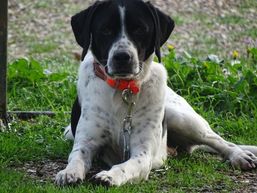 Oscar, tied up for once. enjoys the Greek sunshine.
Oscar, tied up for once. enjoys the Greek sunshine.
Weather
We saw the North of England floods on the internet, and later the Scottish ones. The York area really had a hard time. We also noted that when the BBC reporter (a southerner) commented on the floods in the Calder Valley he only mentioned Hebden Bridge. He probably could not cope with Luddenden Foot and Mytholmroyd. Poor lad.
Our weather has been glorious every day up to around the 11th of January when the rain started. We had a three day period of thunderstorms with high winds but that soon changed.
We saw the North of England floods on the internet, and later the Scottish ones. The York area really had a hard time. We also noted that when the BBC reporter (a southerner) commented on the floods in the Calder Valley he only mentioned Hebden Bridge. He probably could not cope with Luddenden Foot and Mytholmroyd. Poor lad.
Our weather has been glorious every day up to around the 11th of January when the rain started. We had a three day period of thunderstorms with high winds but that soon changed.
|
|
|
|
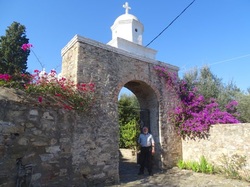 Entrance to Koroni convent.
Entrance to Koroni convent.
28 January 2016, Koroni
Such a lovely day to have an excursion to Koroni. It’s a lovely little town crowned by the 13th Century Venetian castle. In the 16th Century it was updated by the Ottomans. Inside are some houses, still inhabited, where people were protected from pirates. There is also the delightful Timios Prodromos convent occupied by a few old ladies. They always have a few pieces of “Turkish” delight to welcome visitors.
Below the convent is the church dedicated to Panagia Eleistra in an attractive palm grove. Back up to the castle and enjoy the views over the harbour and the sea all the way to Kalamata. Today a little spoilt because money is being spent on rebuilding sea walls, which means that trucks loaded with rocks trundle along the sea front.
Naturally we wandered the narrow streets before visiting the church and the convent. Much of the town is on a hillside so be prepared for steep climbs, sometimes on uneven steps. House walls are generally whitewashed and in some places so is the road outside. On the outer edges of the town are some “atmospheric” old businesses, from ironmongers to carpenters.
Back down on the sea front we enjoyed some tasty coffee and simply watched the world go by. Nice.
Such a lovely day to have an excursion to Koroni. It’s a lovely little town crowned by the 13th Century Venetian castle. In the 16th Century it was updated by the Ottomans. Inside are some houses, still inhabited, where people were protected from pirates. There is also the delightful Timios Prodromos convent occupied by a few old ladies. They always have a few pieces of “Turkish” delight to welcome visitors.
Below the convent is the church dedicated to Panagia Eleistra in an attractive palm grove. Back up to the castle and enjoy the views over the harbour and the sea all the way to Kalamata. Today a little spoilt because money is being spent on rebuilding sea walls, which means that trucks loaded with rocks trundle along the sea front.
Naturally we wandered the narrow streets before visiting the church and the convent. Much of the town is on a hillside so be prepared for steep climbs, sometimes on uneven steps. House walls are generally whitewashed and in some places so is the road outside. On the outer edges of the town are some “atmospheric” old businesses, from ironmongers to carpenters.
Back down on the sea front we enjoyed some tasty coffee and simply watched the world go by. Nice.
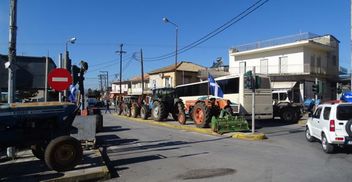 Tractors preparing road block in Kalamata.
Tractors preparing road block in Kalamata.
6 February 2016, Tractors and Teacakes
Now and again we drive out to Messini to visit LIDL with the intention of stocking up on the things that are not available in the local shops. This time we nearly found ourselves in a farmers’ road block. All around one of the main road junctions we could see the tractors preparing to block the road. Farmers are protesting about the pensions overhaul which will bring in larger taxes and a tripling of their social security contributions.
Farmers claim that they are already living on loans and that the reforms will destroy them. The EU and the International Monetary Fund are not expected to back down on their demands that Athens cut pension spending by 1 percent of gross domestic product this year. The IMF said Greece will need to take extra measures worth about 9 billion euros to meet its fiscal targets by 2018.
Now and again we drive out to Messini to visit LIDL with the intention of stocking up on the things that are not available in the local shops. This time we nearly found ourselves in a farmers’ road block. All around one of the main road junctions we could see the tractors preparing to block the road. Farmers are protesting about the pensions overhaul which will bring in larger taxes and a tripling of their social security contributions.
Farmers claim that they are already living on loans and that the reforms will destroy them. The EU and the International Monetary Fund are not expected to back down on their demands that Athens cut pension spending by 1 percent of gross domestic product this year. The IMF said Greece will need to take extra measures worth about 9 billion euros to meet its fiscal targets by 2018.
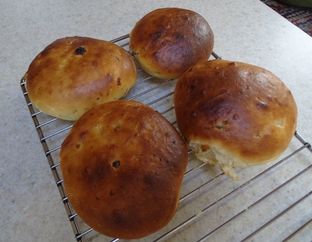 Real Yorkshire teacakes.
Real Yorkshire teacakes.
So the situation at the moment is that the EU and IMF want reforms while at the same time the EU has effectively forced 70,000 refugees to remain in Greece. On 4 March 2016 12,000 are stuck at the Idomeni border crossing with Macedonia.
But to all those thinking of holidaying in Greece but are afraid of the migrant situation... don’t worry. Go to the Peloponnese.
To more comforting matters. Ian made some delicious Yorkshire teacakes which were fabulous when toasted and covered in lashings of real butter. Yummy.
But to all those thinking of holidaying in Greece but are afraid of the migrant situation... don’t worry. Go to the Peloponnese.
To more comforting matters. Ian made some delicious Yorkshire teacakes which were fabulous when toasted and covered in lashings of real butter. Yummy.
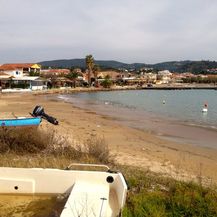 Finikunda by iPhone.
Finikunda by iPhone.
17 February 2016, iPhone testing
We love taking photos but sometimes a big-boy’s camera is too bulky. Today we went for a walk into Finikunda with the iPhone and tried out the built in camera. The photos turned out to be quite good, we think you will agree. Not good enough for a giant poster but perfectly OK for a website. One problem is remembering where the lens is located as it was easy to take a photo of a finger. Here is one shot and the rest mixed in with the gallery shots.
We love taking photos but sometimes a big-boy’s camera is too bulky. Today we went for a walk into Finikunda with the iPhone and tried out the built in camera. The photos turned out to be quite good, we think you will agree. Not good enough for a giant poster but perfectly OK for a website. One problem is remembering where the lens is located as it was easy to take a photo of a finger. Here is one shot and the rest mixed in with the gallery shots.
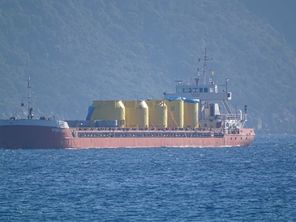 Whiskey Trio in Finikunda Bay.
Whiskey Trio in Finikunda Bay.
Black Ships
Albert and Ian often play with Marine Traffic which is, among many things, an internet ship tracker. For two days we had a general cargo ship in the bay. It happens sometimes when the sea is rough. But the sea was calm. What was Whiskey Trio up to?
Later we noted it off the coast of Sicily and later dawdling around the Libyan coast. We took no further notice. But sometime later we spotted it in a Danish harbour, loaded with weapons and rockets. Then you have to ask again, what is it doing?
There are ships known as Black Ships that do strange things to arouse suspicion; such as leaving Gibraltar and heading into the Atlantic, drifting around for two or three days before heading back to the Spanish coast. Maybe Whiskey Trio is a Black Ship.
Albert and Ian often play with Marine Traffic which is, among many things, an internet ship tracker. For two days we had a general cargo ship in the bay. It happens sometimes when the sea is rough. But the sea was calm. What was Whiskey Trio up to?
Later we noted it off the coast of Sicily and later dawdling around the Libyan coast. We took no further notice. But sometime later we spotted it in a Danish harbour, loaded with weapons and rockets. Then you have to ask again, what is it doing?
There are ships known as Black Ships that do strange things to arouse suspicion; such as leaving Gibraltar and heading into the Atlantic, drifting around for two or three days before heading back to the Spanish coast. Maybe Whiskey Trio is a Black Ship.
 Pylos Castle. Photo from a tourist website.
Pylos Castle. Photo from a tourist website.
20 February 2016, A Night Out
Just for the fun of it we planned a night out of the camp. We had to go to the doctors in Pylos to see if they could give us prescriptions for our various medicines. Luckily they did, but it took quite a while to complete the business with the computer system. Five minutes chat per patient and 20 minutes filling in the computer data.
After that we went into town and handed the prescriptions to the helpful pharmacy. We had time on our hands so we enjoyed yet another gyros and then walked to the castle. It really is very pleasant.
The castle, Niokastro, was built during the Turkish occupation in 1573 to control the western coast of the Peloponnese. In the grounds is a museum dedicated to underwater archeology. One of the charming museum staff gave us a very interesting guided tour of the whole complex.
Just for the fun of it we planned a night out of the camp. We had to go to the doctors in Pylos to see if they could give us prescriptions for our various medicines. Luckily they did, but it took quite a while to complete the business with the computer system. Five minutes chat per patient and 20 minutes filling in the computer data.
After that we went into town and handed the prescriptions to the helpful pharmacy. We had time on our hands so we enjoyed yet another gyros and then walked to the castle. It really is very pleasant.
The castle, Niokastro, was built during the Turkish occupation in 1573 to control the western coast of the Peloponnese. In the grounds is a museum dedicated to underwater archeology. One of the charming museum staff gave us a very interesting guided tour of the whole complex.
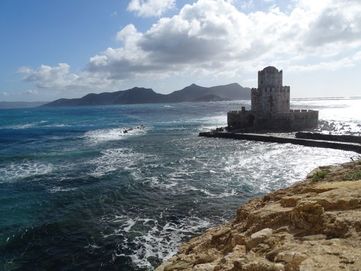 The Bourtzi part of Methoni Castle.
The Bourtzi part of Methoni Castle.
Back to the town square with its monument to the Battle of Navarino for a relaxing coffee before taking Bessy to Methoni where we stopped for the night on the sea front. Not possible in Summer but OK out of season. In the evening we enjoyed a few beers in the “pub” before having a meal out.
In the morning we just had to walk around Methoni Castle again. Built by the Venetians in the early 13th century on a rocky promontory, the castle is among the largest ones in the Mediterranean. A 14 arch bridge connects the castle to the shore instead of the timber one that used to stand in its place before the Venetians got there.
The symbol of Venice, the lion of St Marc, dominates the gate of the castle. The relics of two Ottoman bath houses have survived. At the south edge of the castle is the fortified islet of Bourtzi. A prison and place of executions during the Turkish Occupation. It was built in 1500 and is connected to the Sea Gate of the castle with a paved tiny road.
It gets better every time. This time we were amazed at the size of the sea swell which was crashing around the tower and the castle walls. A very enjoyable two days.
If you want to see the castle from the air check out the YouTube video here:
https://www.youtube.com/watch?v=kppmNv3HY-4
In the morning we just had to walk around Methoni Castle again. Built by the Venetians in the early 13th century on a rocky promontory, the castle is among the largest ones in the Mediterranean. A 14 arch bridge connects the castle to the shore instead of the timber one that used to stand in its place before the Venetians got there.
The symbol of Venice, the lion of St Marc, dominates the gate of the castle. The relics of two Ottoman bath houses have survived. At the south edge of the castle is the fortified islet of Bourtzi. A prison and place of executions during the Turkish Occupation. It was built in 1500 and is connected to the Sea Gate of the castle with a paved tiny road.
It gets better every time. This time we were amazed at the size of the sea swell which was crashing around the tower and the castle walls. A very enjoyable two days.
If you want to see the castle from the air check out the YouTube video here:
https://www.youtube.com/watch?v=kppmNv3HY-4
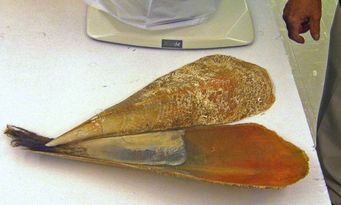 Fan Mussel.
Fan Mussel.
21 February 2016, Wind
Generally the weather has been very pleasant with lots of sunny days. But today the wind started and for the next 10 days we have had to put up with that. Now and again we had heavy rain. The southerly wind has brought some really big seas which have deposited lots of shells on the beach. The best was a shell from a “Fan Mussel”. The general shape is like an ice-cream cone with sides that are almost flat. It grows to 48cm in length. The outer shell is almost transparent.
This photo, found on the internet, is by By John Hill - Own work, CC BY-SA 3.0, https://commons.wikimedia.org/w/index.php?curid=4538632
The shell adheres itself to rocks with a tuft of very strong thin fibres, pointed end down. These byssus or filaments (which can be up to 6 cm long) are spun and, when treated with lemon juice, turn a golden colour, which never fades.
The cloth produced from these filaments can be woven even finer than silk, and is extremely light and warm. It was said that a pair of women's gloves made from the fabric could fit into half a walnut shell.
Generally the weather has been very pleasant with lots of sunny days. But today the wind started and for the next 10 days we have had to put up with that. Now and again we had heavy rain. The southerly wind has brought some really big seas which have deposited lots of shells on the beach. The best was a shell from a “Fan Mussel”. The general shape is like an ice-cream cone with sides that are almost flat. It grows to 48cm in length. The outer shell is almost transparent.
This photo, found on the internet, is by By John Hill - Own work, CC BY-SA 3.0, https://commons.wikimedia.org/w/index.php?curid=4538632
The shell adheres itself to rocks with a tuft of very strong thin fibres, pointed end down. These byssus or filaments (which can be up to 6 cm long) are spun and, when treated with lemon juice, turn a golden colour, which never fades.
The cloth produced from these filaments can be woven even finer than silk, and is extremely light and warm. It was said that a pair of women's gloves made from the fabric could fit into half a walnut shell.
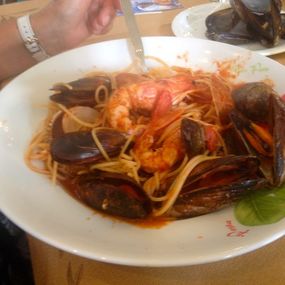 Judit's "Spag Fish".
Judit's "Spag Fish".
3 March 2016, Happy Burnt Thursday
Judit and Rose almost share the same birthday. Rose and Alf took us to a very good fish restaurant in Koroni. The weather was lovely so we sat on the sea front to enjoy a cool beer. Along with the beers came sticks of souvlaki. Today was “Burnt Thursday” when everyone takes a chance to eat meat before they fast until Easter. What a lovely tradition.
The Friday, Saturday, and Sunday preceding "Clean Monday" usually offer vigorous parties, parades, and traditional events wherever Carnival is celebrated. In larger towns or cities "known" for Carnival, such as Rethimno or Patras, the previous weekend will also be filled with activities.
The last Sunday of the Carnival period is known as "Cheese-eating Sunday" or Tyrofagos as no meat products are allowed at this time. Macaroni is often served on this day. Surprisingly enough, the word "macaroni" is not Italian, but comes from the Greek words macaria or "blessed", and aeronia or "eternal". Thus, "macaroni". The preceding day, Saturday, is a special service for the dead in Orthodox churches, and part of the rites includes the making of grain dishes. Thus, "macaroni".
"Clean Monday" or Kathari Deftera, is the actual the first day of Lent (Sarakosti). While a holiday atmosphere still prevails, the foods consumed are all "pure", without bloodshed. But this allows cuttlefish and squid, fish roe, and other items.
The fish restaurant is called Kaggelarios. http://kaggelarios-koroni.com/index_gb.htm
The food was delicious and lots of it. Ian had a plate of mussels in white wine while Alf ate the mussels in cheese and tomato. Judit had seafood with spaghetti. We all enjoyed our meal.
Judit and Rose almost share the same birthday. Rose and Alf took us to a very good fish restaurant in Koroni. The weather was lovely so we sat on the sea front to enjoy a cool beer. Along with the beers came sticks of souvlaki. Today was “Burnt Thursday” when everyone takes a chance to eat meat before they fast until Easter. What a lovely tradition.
The Friday, Saturday, and Sunday preceding "Clean Monday" usually offer vigorous parties, parades, and traditional events wherever Carnival is celebrated. In larger towns or cities "known" for Carnival, such as Rethimno or Patras, the previous weekend will also be filled with activities.
The last Sunday of the Carnival period is known as "Cheese-eating Sunday" or Tyrofagos as no meat products are allowed at this time. Macaroni is often served on this day. Surprisingly enough, the word "macaroni" is not Italian, but comes from the Greek words macaria or "blessed", and aeronia or "eternal". Thus, "macaroni". The preceding day, Saturday, is a special service for the dead in Orthodox churches, and part of the rites includes the making of grain dishes. Thus, "macaroni".
"Clean Monday" or Kathari Deftera, is the actual the first day of Lent (Sarakosti). While a holiday atmosphere still prevails, the foods consumed are all "pure", without bloodshed. But this allows cuttlefish and squid, fish roe, and other items.
The fish restaurant is called Kaggelarios. http://kaggelarios-koroni.com/index_gb.htm
The food was delicious and lots of it. Ian had a plate of mussels in white wine while Alf ate the mussels in cheese and tomato. Judit had seafood with spaghetti. We all enjoyed our meal.
 A selection of Greek Carnival faces.
A selection of Greek Carnival faces.
6 March 2016, Carnival in Finikunda
The next major event in our winter season was Carnival in Finikunda. While Patras may have the largest carnival in Greece (third in the world) Finikunda has probably the smallest carnival in Greece with just one tractor pulling one trailer. However that adds to the charm. Many people dress in unusual costumes, maidens patrol the streets with free glasses of wine, people dance in the street and generally it is a very sociable event.
It’s good to see the Greeks have not lost a sense of humour during these difficult times when the population is being swollen with immigrants. Check out the photos.
There are more pictures in the gallery.
The next major event in our winter season was Carnival in Finikunda. While Patras may have the largest carnival in Greece (third in the world) Finikunda has probably the smallest carnival in Greece with just one tractor pulling one trailer. However that adds to the charm. Many people dress in unusual costumes, maidens patrol the streets with free glasses of wine, people dance in the street and generally it is a very sociable event.
It’s good to see the Greeks have not lost a sense of humour during these difficult times when the population is being swollen with immigrants. Check out the photos.
There are more pictures in the gallery.
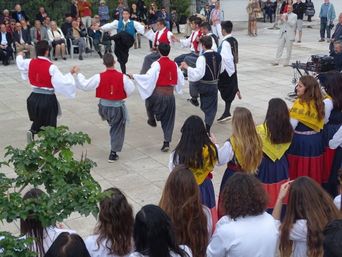 School students dancing in Kardamyli.
School students dancing in Kardamyli.
24 March 2016, Bessy on the move
A fond farewell to Albert, Gabi, Rod and Oscar. We’ve had a lovely time with all of them. First stop Pylos for a bit of shopping then on to LIDL at Messini before driving through Kalamata. The road to Kardamyli was described by our good friend Mike as the most picturesque he had been on. We have to agree with him. We parked in our usual spot on the seafront next to the village football field. The weather is a bit blustery and threatening rain all the time.
In the morning we walked to the village to see the celebrations for the liberation of Greece from the Turks. This year was much more low key than last time, but still fun for all with dancing in the square and a parade. The weather was good for the events and then it really poured down. The young lad at the cafe got really soaked trying to pull the awning over the customers.
A fond farewell to Albert, Gabi, Rod and Oscar. We’ve had a lovely time with all of them. First stop Pylos for a bit of shopping then on to LIDL at Messini before driving through Kalamata. The road to Kardamyli was described by our good friend Mike as the most picturesque he had been on. We have to agree with him. We parked in our usual spot on the seafront next to the village football field. The weather is a bit blustery and threatening rain all the time.
In the morning we walked to the village to see the celebrations for the liberation of Greece from the Turks. This year was much more low key than last time, but still fun for all with dancing in the square and a parade. The weather was good for the events and then it really poured down. The young lad at the cafe got really soaked trying to pull the awning over the customers.
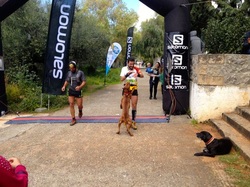 Happy dog greets runner's return.
Happy dog greets runner's return.
In the mornings we went to Gialos taverna where Rick Stein stayed for stuffed tomatoes on his Venice to Istanbul journey.
The following day we walked most of the way up the rocky path towards Agios Sofia church. We were getting in the way of runners who were competing in the Taygetos Challenge. They had to run 36 kilometers over really hilly, rough terrain. Quite amazing. One man arrived at the finish to be greeted by his dog; it was so happy to see him again.
The following day we walked most of the way up the rocky path towards Agios Sofia church. We were getting in the way of runners who were competing in the Taygetos Challenge. They had to run 36 kilometers over really hilly, rough terrain. Quite amazing. One man arrived at the finish to be greeted by his dog; it was so happy to see him again.
 View from Gregg's Platea.
View from Gregg's Platea.
28 March 2016, Agios Nikolaos
At last the weather seems to have turned and we had a lovely short drive to Ag. Nik. We made use of the excellent supermarket called Katerina’s near Stoupa before taking up residence in the Ag. Nik. car park.
First job was to walk into the village and have a chat with Freda and her friend Pat at Gregg’s Plataei. We went there the next morning for coffee and internet. Freda’s assistant Niki was there and her English is very much improved. She also has a South African accent thanks to Freda.
After coffee we made the walk into Stoupa along the coast path. It really is a good walk and well surfaced for bikes. Stoupa was almost deserted except for a few ex-pats. Sadly the “Pork Butcher’s” place was still in a bad way after it burned down a few year ago.
At last the weather seems to have turned and we had a lovely short drive to Ag. Nik. We made use of the excellent supermarket called Katerina’s near Stoupa before taking up residence in the Ag. Nik. car park.
First job was to walk into the village and have a chat with Freda and her friend Pat at Gregg’s Plataei. We went there the next morning for coffee and internet. Freda’s assistant Niki was there and her English is very much improved. She also has a South African accent thanks to Freda.
After coffee we made the walk into Stoupa along the coast path. It really is a good walk and well surfaced for bikes. Stoupa was almost deserted except for a few ex-pats. Sadly the “Pork Butcher’s” place was still in a bad way after it burned down a few year ago.
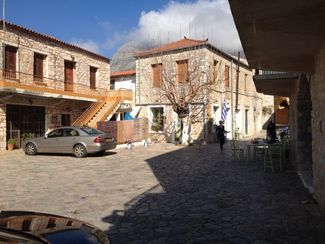 Lithostroto Taverna, with flag.
Lithostroto Taverna, with flag.
29 March 2016, Areopolis
On the move again. We stopped for lunch on the seafront at Neo Otilo before the short uphill journey to Areopolis. This time we parked in the “bus station” car park next to the cafe. During a stroll through and around the town we found the Lithostroto taverna where Rick Stein ate goat with artichokes so we arranged to return in the evening and try the same. It was delicious and the cook Maria told us that the BBC crew were charming.
On the move again. We stopped for lunch on the seafront at Neo Otilo before the short uphill journey to Areopolis. This time we parked in the “bus station” car park next to the cafe. During a stroll through and around the town we found the Lithostroto taverna where Rick Stein ate goat with artichokes so we arranged to return in the evening and try the same. It was delicious and the cook Maria told us that the BBC crew were charming.
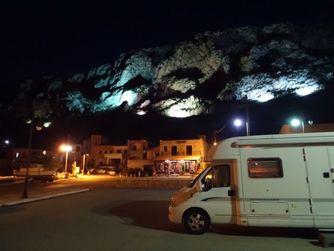 Gerolimenas cliffs at night.
Gerolimenas cliffs at night.
30 March 2016, Gerolimenas
The bus station cafe was excellent and we enjoyed coffees and internet before moving on. There was a very beautiful old stove in the cafe. Check the gallery for a photo.
Our destination was Gerolimenas. Although we have driven down the Mani several times we never visited the village. It is in a charming setting under imposing cliffs. There is an excellent car park opposite the hotel and that gave us a good night’s sleep. Sadly parts of the village are in disrepair, but other parts are being renewed.
We had a walk around the area and saw two 12 year old boys collecting limpets which they said they were going to eat. Much to our surprise they climbed into a large Toyota pick-up and drove off. Hopefully they will not collide with anyone!
A second surprise in store in the evening. Floodlights lit up the cliff face and showed the footpath to the top. Before WWII that had been the main road!
The bus station cafe was excellent and we enjoyed coffees and internet before moving on. There was a very beautiful old stove in the cafe. Check the gallery for a photo.
Our destination was Gerolimenas. Although we have driven down the Mani several times we never visited the village. It is in a charming setting under imposing cliffs. There is an excellent car park opposite the hotel and that gave us a good night’s sleep. Sadly parts of the village are in disrepair, but other parts are being renewed.
We had a walk around the area and saw two 12 year old boys collecting limpets which they said they were going to eat. Much to our surprise they climbed into a large Toyota pick-up and drove off. Hopefully they will not collide with anyone!
A second surprise in store in the evening. Floodlights lit up the cliff face and showed the footpath to the top. Before WWII that had been the main road!
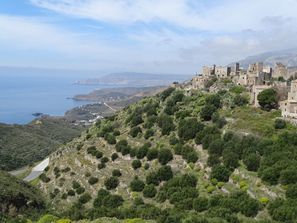 Stone towers of Vathia.
Stone towers of Vathia.
31 March 2016, The Cape
We took the road south through dramatic scenery towards Cape Tenaro which is as far South East as possible in Europe. On the way we passed through Vathia. It is a well preserved village of tower houses which the locals used to defend themselves. Then past Marmari to the Cape. We did not take the walk as we had been there not long ago but stopped for lunch.
We took the road south through dramatic scenery towards Cape Tenaro which is as far South East as possible in Europe. On the way we passed through Vathia. It is a well preserved village of tower houses which the locals used to defend themselves. Then past Marmari to the Cape. We did not take the walk as we had been there not long ago but stopped for lunch.
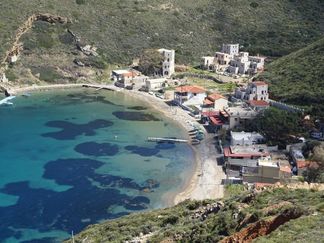 Porto Kagio. Drive on beach to car park.
Porto Kagio. Drive on beach to car park.
After a rest we retraced our steps and called at Porto Kagio. It really is one of the most picturesque villages in the country. After a 1 in 3 descent we drove along the beach to the car park.
Once organised we went for a drink and a meal at Porto Taverna. Maria and her husband were really charming. The English menu was a bit confusing as Egg Fish Salad turned out to be taramasalata. Judit ate squid and Ian had the “small fish” which was really whitebait. We also had a serving of “Green Wild Pie”. It was very much like a paratha stuffed with winter greens; usually dandelion from the fields. All were excellent.
Once organised we went for a drink and a meal at Porto Taverna. Maria and her husband were really charming. The English menu was a bit confusing as Egg Fish Salad turned out to be taramasalata. Judit ate squid and Ian had the “small fish” which was really whitebait. We also had a serving of “Green Wild Pie”. It was very much like a paratha stuffed with winter greens; usually dandelion from the fields. All were excellent.
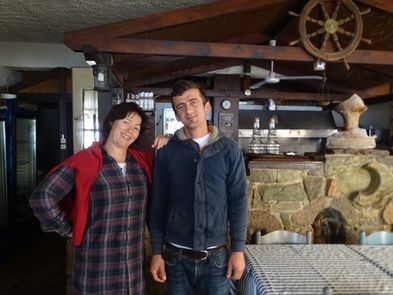 Maria and husband, Porto Taverna.
Maria and husband, Porto Taverna.
2 April 2016 Free Veg
Once again we returned to the cafe for internet and coffee. The internet is amazingly good when you compare it with a UK village. Porto Kagio only has about 10 houses and is miles from anywhere, but they still had cable internet.
Maria gave Judit a take-away box of pickled greens. They looked like some sort of seaweed. We have no idea but they go down well with a salad.
Next stop, back to Areopolis for a bit of shopping. The superb butcher had some fresh liver, some great smoked sausages and mince, so after a call at the supermarket we were set up for a while.
Then we had a scenic downhill run to Gythio where we have camped before. The big and pleasant surprise was the quality of the internet. In previous years it has been terrible, but now it is over the whole camp. It is still a bit flaky.
It was also good to meet Ian and Wendy who were on their first visit to Greece. Lots of nattering with Ian while Judit did some washing.
Once again we returned to the cafe for internet and coffee. The internet is amazingly good when you compare it with a UK village. Porto Kagio only has about 10 houses and is miles from anywhere, but they still had cable internet.
Maria gave Judit a take-away box of pickled greens. They looked like some sort of seaweed. We have no idea but they go down well with a salad.
Next stop, back to Areopolis for a bit of shopping. The superb butcher had some fresh liver, some great smoked sausages and mince, so after a call at the supermarket we were set up for a while.
Then we had a scenic downhill run to Gythio where we have camped before. The big and pleasant surprise was the quality of the internet. In previous years it has been terrible, but now it is over the whole camp. It is still a bit flaky.
It was also good to meet Ian and Wendy who were on their first visit to Greece. Lots of nattering with Ian while Judit did some washing.
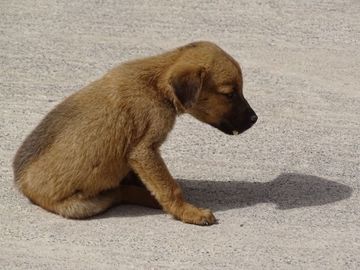 A very dehydrated lonely puppy.
A very dehydrated lonely puppy.
6 April 2016, Bozas the puppy
From Gythio it’s a short run to Skala where they have a LIDL. Time to stock up on a few things. Then we trundled south down the Third Finger and after a lunch break on a beach we arrived at Bozas Taverna.
We’ve been here before and the place is just as lovely. The nice surprise was the presence of a Swedish motorhome with Julian and Stina. What a lovely chance encounter with a really friendly couple.
From a distance Judit spotted a strange small creature with not much tail. Later in the day it came back and we realised it was a stray puppy. The poor thing could not have been older than a few weeks and it was desperately attempting to lap up some water that had dripped from a tap. It really was on its last legs.
The team quickly swung into action. The poor thing was covered in tics and fleas. First job was to give him some fluids and he quickly slurped down about half a cup of milk. Next job, to hold him down while Julian removed around 60 tics. Because Julian and Stina had a dog they also had a box of dog goodies. His back was plastered with anti tic/flea juice and then we gave him half a worming tablet. His eyes were clagged up with sand a secretions so they needed a good clean. Optrex did the trick.
From Gythio it’s a short run to Skala where they have a LIDL. Time to stock up on a few things. Then we trundled south down the Third Finger and after a lunch break on a beach we arrived at Bozas Taverna.
We’ve been here before and the place is just as lovely. The nice surprise was the presence of a Swedish motorhome with Julian and Stina. What a lovely chance encounter with a really friendly couple.
From a distance Judit spotted a strange small creature with not much tail. Later in the day it came back and we realised it was a stray puppy. The poor thing could not have been older than a few weeks and it was desperately attempting to lap up some water that had dripped from a tap. It really was on its last legs.
The team quickly swung into action. The poor thing was covered in tics and fleas. First job was to give him some fluids and he quickly slurped down about half a cup of milk. Next job, to hold him down while Julian removed around 60 tics. Because Julian and Stina had a dog they also had a box of dog goodies. His back was plastered with anti tic/flea juice and then we gave him half a worming tablet. His eyes were clagged up with sand a secretions so they needed a good clean. Optrex did the trick.
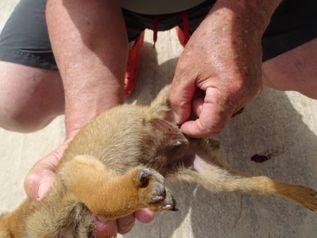 Removing about 60 tics was not easy. Look at the blood on the floor.
Removing about 60 tics was not easy. Look at the blood on the floor.
The poor unfortunate was so ill that he did not object to anything we did to him; just the occasional squeal when a tic proved hard to remove.
That evening we made him a little house from an abandoned plastic crate, carpet and some cardboard. We then tucked him into the corner of the beach bar out of the wind.
To our surprise he was still alive in the morning and even able to walk about a bit. Or should we say, stagger. It seemed right to give him a name so we called him Bozas after the taverna. Over the next few days we fed and watered him and continued his treatment. He even got a bath and did not object at all. The best shampoo gave him a lovely fluffy fur and a very un-dog-like smell.
That evening we made him a little house from an abandoned plastic crate, carpet and some cardboard. We then tucked him into the corner of the beach bar out of the wind.
To our surprise he was still alive in the morning and even able to walk about a bit. Or should we say, stagger. It seemed right to give him a name so we called him Bozas after the taverna. Over the next few days we fed and watered him and continued his treatment. He even got a bath and did not object at all. The best shampoo gave him a lovely fluffy fur and a very un-dog-like smell.
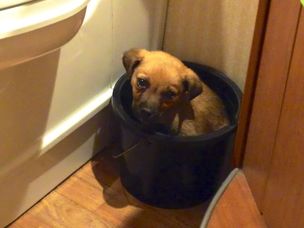 Why climb into a very small bucket at 02-30 ?
Why climb into a very small bucket at 02-30 ?
The next night we put his little house next to Bessy’s door. However the wind really picked up in the night so we brought him in and made him comfortable on the inside step. Having a puppy is like caring for a child. At 02-30 he started whining and Ian got up to make sure he had water and a cuddle. At that age he should have had a mum to snuggle up to. After a while Bozas decided to explore the motorhome and he really was awake. Within a few minutes he had managed to put himself into a small container that Judit uses for floorcloths. Then he decided to do a bit more exploring before having another go at the container. This time one back leg did not make it over the rim and he ended up head first in the tub. The howls were so loud he woke Judit... and that takes some doing.
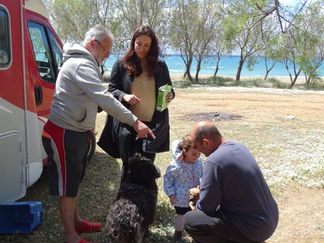 Bozas new chance in life.
Bozas new chance in life.
Over the next few days we fed and watered him. Julian fitted him a section of spare flea collar. He also spent a night with Julian and Stina and their dog Bonnie. Our worry was that we may have to abandon the puppy. How could we bring him home? He would need a chip and various vaccinations but he was too young for some of them. All of us were concerned about the future of young Bozas who was now happily following us around; just like a puppy should.
On the Saturday the taverna owner came round to tell us he had a customer for the puppy; a local family with a young girl. They were delighted with Bozas and assured us that he would not be chained up all day as they had a garden. A good result all round... but we all miss him very much.
On the Saturday the taverna owner came round to tell us he had a customer for the puppy; a local family with a young girl. They were delighted with Bozas and assured us that he would not be chained up all day as they had a garden. A good result all round... but we all miss him very much.
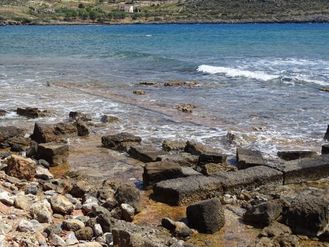 Submerged town at Plytra.
Submerged town at Plytra.
11 April 2016 Paleokastro
Heading south again we stopped at Plytra to look at the underwater town ruins. There was something to see as it was not completely submerged. Then it was time for a coffee and internet before heading to Neapoli.
Stock up in the local supermarket before meandering around the town. In the afternoon we set the GPS to take us to Paleokastro. Julian had told us of a good night stop. The route took us uphill and then down a quite hazardous narrow road with hairpin bends to the stop. A distance of over 7 kilometers.
In the evening we had a walk up to the castle on the hill. There is no castle to be seen, but there is a church and a fine view of Neapoli. From the hill we could also see a wide dirt road heading for Neapoli along the seaside. Naturally we meandered along that way and asked a local if the road was OK. He assured is it was perfect.
In the morning we checked with the GPS. It had no dirt road at all going to Neapoli. Nevertheless we pointed Bessy in that direction. As soon as we hit the dirt road the road appeared on the map! We were in Neapoli again within 10 minutes after covering only 2 kilometers. We wrote and pointed this out to Garmin but we only got a standard waffle in return. Surely the track was already in the memory of the machine. Why was it not shown?
Heading south again we stopped at Plytra to look at the underwater town ruins. There was something to see as it was not completely submerged. Then it was time for a coffee and internet before heading to Neapoli.
Stock up in the local supermarket before meandering around the town. In the afternoon we set the GPS to take us to Paleokastro. Julian had told us of a good night stop. The route took us uphill and then down a quite hazardous narrow road with hairpin bends to the stop. A distance of over 7 kilometers.
In the evening we had a walk up to the castle on the hill. There is no castle to be seen, but there is a church and a fine view of Neapoli. From the hill we could also see a wide dirt road heading for Neapoli along the seaside. Naturally we meandered along that way and asked a local if the road was OK. He assured is it was perfect.
In the morning we checked with the GPS. It had no dirt road at all going to Neapoli. Nevertheless we pointed Bessy in that direction. As soon as we hit the dirt road the road appeared on the map! We were in Neapoli again within 10 minutes after covering only 2 kilometers. We wrote and pointed this out to Garmin but we only got a standard waffle in return. Surely the track was already in the memory of the machine. Why was it not shown?
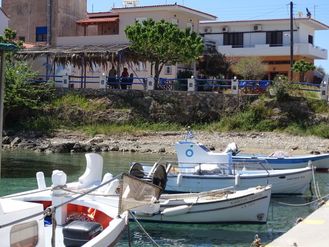 Sleepy village of Archangelos.
Sleepy village of Archangelos.
12 April 2016 To Monemvasia
Now we were in Neapoli we went for a coffee and internet. The coffee was good but the internet was useless. I hate buying a coffee for nothing so we left, headed north and stopped in Archangelos for a walkabout. It’s a lovely sleepy little village and well worth a stopover. Do not drive into the village if you have a motorhome. You have been warned, there are some very tight bends.
After our stroll we diverted back to our favourite taverna in Plytra and had a coffee and good internet before heading for Monemvasia. The road is really good and gives the impression of having been built to take tourist coaches.
Who should we meet in the town but Julian and Stina. We parked alongside them on the car park at the island before walking back to town and enjoying a coffee together.
In the afternoon Judit walked up to the medieval town and enjoyed browsing the Malva art gallery. She reported back that while meandering the narrow streets that more and more houses are being renovated..
Once the traffic had stopped we had a really peaceful night. In the morning Ian spotted what looked like a small head above the water. It seems that there are lots of large turtles in the area.
Now we were in Neapoli we went for a coffee and internet. The coffee was good but the internet was useless. I hate buying a coffee for nothing so we left, headed north and stopped in Archangelos for a walkabout. It’s a lovely sleepy little village and well worth a stopover. Do not drive into the village if you have a motorhome. You have been warned, there are some very tight bends.
After our stroll we diverted back to our favourite taverna in Plytra and had a coffee and good internet before heading for Monemvasia. The road is really good and gives the impression of having been built to take tourist coaches.
Who should we meet in the town but Julian and Stina. We parked alongside them on the car park at the island before walking back to town and enjoying a coffee together.
In the afternoon Judit walked up to the medieval town and enjoyed browsing the Malva art gallery. She reported back that while meandering the narrow streets that more and more houses are being renovated..
Once the traffic had stopped we had a really peaceful night. In the morning Ian spotted what looked like a small head above the water. It seems that there are lots of large turtles in the area.
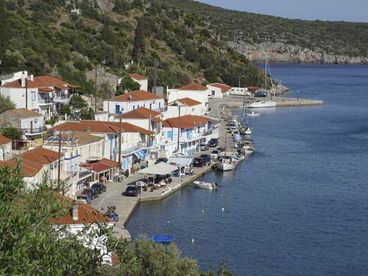 Limani Geraka. We are at the far end.
Limani Geraka. We are at the far end.
13 April 2016 Limani Gerakas
In the morning we said goodbye again to Julian and Stina before filling up at the pump opposite and heading north to Limani Gerakas. We spent some time here last year and find it very peaceful and very picturesque.
The weather is now really warming up and we have had no rain for some weeks. Wind has been the problem and several nights while we were on the quayside we were wobbled around.
We mentioned we have been here before and we had no electricity for charging the laptop, etc. On our third day here we noticed a small covered socket on the outside wall of the “medical centre”. At last we had electricity and it was free. The “medical centre” seems to have been a project that kept somebody quiet for a few weeks. Both times we have been here it gets more and more run down and never appears to have been used at all.
Just our luck that on the day we found the socket a German couple arrived and shared it with us. He explained at some length that it would be very useful because they had a fridge, electric kettle, heater, laptop, several batteries to charge and an air conditioner. Ian had to explain to him in words of half a syllable that he would be very unhappy if our continental friend was to blow a fuse and that he should limit himself to one item at a time.
In the morning we said goodbye again to Julian and Stina before filling up at the pump opposite and heading north to Limani Gerakas. We spent some time here last year and find it very peaceful and very picturesque.
The weather is now really warming up and we have had no rain for some weeks. Wind has been the problem and several nights while we were on the quayside we were wobbled around.
We mentioned we have been here before and we had no electricity for charging the laptop, etc. On our third day here we noticed a small covered socket on the outside wall of the “medical centre”. At last we had electricity and it was free. The “medical centre” seems to have been a project that kept somebody quiet for a few weeks. Both times we have been here it gets more and more run down and never appears to have been used at all.
Just our luck that on the day we found the socket a German couple arrived and shared it with us. He explained at some length that it would be very useful because they had a fridge, electric kettle, heater, laptop, several batteries to charge and an air conditioner. Ian had to explain to him in words of half a syllable that he would be very unhappy if our continental friend was to blow a fuse and that he should limit himself to one item at a time.
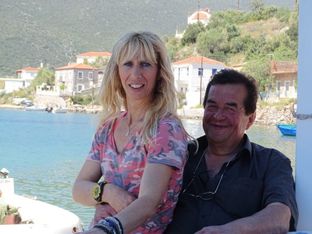 Kristi and Ioannis of ZHKOS Taverna.
Kristi and Ioannis of ZHKOS Taverna.
We drank every day at ZHKOS Taverna. Both Kristi and Ioannis were very kind in allowing us to charge the laptop and check the internet. They even encouraged Ian to watch the Chinese Grand Prix on the laptop. Good old Filmon.com.
For such a small village we had some trouble finding the church, but we had no trouble finding the Acropolis of Zarax and the old Myceanian walls.
Naturally we also ate at the taverna a couple of times. On the day we left we had a lunch of octopus in red wine sauce. It really was delicious.
For such a small village we had some trouble finding the church, but we had no trouble finding the Acropolis of Zarax and the old Myceanian walls.
Naturally we also ate at the taverna a couple of times. On the day we left we had a lunch of octopus in red wine sauce. It really was delicious.
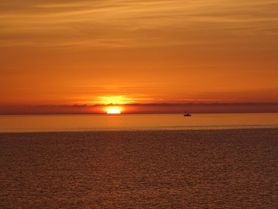 Sunrise at Ariana Beach.
Sunrise at Ariana Beach.
18 April 2016 Backtracking
Kristi had told us of a Dutch couple stopping at Ariana Beach so when we left Limani Gerakas we backtracked a few miles to check out the beach. We have passed the area a few times and always promised we would have a look. It really is very easy to reach, unlike the one at Richea. However the parking is quite limited and the beach is very rocky. Not a place for sunbathing. But it is very peaceful. And the sunrise was magnificent.
Kristi had told us of a Dutch couple stopping at Ariana Beach so when we left Limani Gerakas we backtracked a few miles to check out the beach. We have passed the area a few times and always promised we would have a look. It really is very easy to reach, unlike the one at Richea. However the parking is quite limited and the beach is very rocky. Not a place for sunbathing. But it is very peaceful. And the sunrise was magnificent.
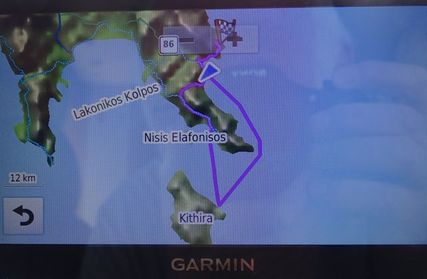 SatNav with sense of humour.
SatNav with sense of humour.
19 April 2016 Over the Hill
The new Garmin SatNav seems to have a wicked sense of humour. Combine that with the poor quality of Greek maps and a 2 hour drive can turn into a four hour one. We planned to travel from Ariana Beach to Plaka. Judit’s paper map showed there was a “brown” road that we should take after 30 minutes. Brown roads on that map are “B roads” to us Brits. But it was not on the SatNav at all.
After a bit of dithering and disagreeing we took the brown road. It was wonderful. Once we were on it the road once again appeared on the SatNav map. We followed it for a good 30 minutes enjoying the smoothness and the width. Then we turned a corner and saw that the tarmac simply ended in a rough dribble as if the contractors had run out of material. From then on it was pure dirt and stone.
(The picture is the screen of the SatNav on a previous witty moment. We wanted to go to the flag about 12 km away. Our arrow is in a car park 200 meters after starting. It then decided that the quickest way to the flag would be to take the ferry to Kithira and then another ferry back to the mainland, drive over the mountains back to the car park. We have written to Garmin!)
The new Garmin SatNav seems to have a wicked sense of humour. Combine that with the poor quality of Greek maps and a 2 hour drive can turn into a four hour one. We planned to travel from Ariana Beach to Plaka. Judit’s paper map showed there was a “brown” road that we should take after 30 minutes. Brown roads on that map are “B roads” to us Brits. But it was not on the SatNav at all.
After a bit of dithering and disagreeing we took the brown road. It was wonderful. Once we were on it the road once again appeared on the SatNav map. We followed it for a good 30 minutes enjoying the smoothness and the width. Then we turned a corner and saw that the tarmac simply ended in a rough dribble as if the contractors had run out of material. From then on it was pure dirt and stone.
(The picture is the screen of the SatNav on a previous witty moment. We wanted to go to the flag about 12 km away. Our arrow is in a car park 200 meters after starting. It then decided that the quickest way to the flag would be to take the ferry to Kithira and then another ferry back to the mainland, drive over the mountains back to the car park. We have written to Garmin!)
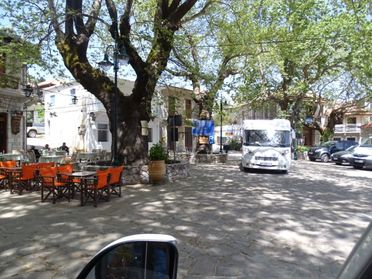 The only place for miles where two motorhomes can pass.
The only place for miles where two motorhomes can pass.
Back to our route to Leonidas. Naturally we decided to turn round and go the original SatNav way. But would you believe it the damned thing had another route in mind. So we took it up the mountain to Kosmas and down the other side to Leonidas. We’ve been this way before and have to say it is absolutely beautiful. The highest point of the road is about 3800 feet above sea level. The views are fantastic. And our luck was changing because as we squeezed our way into Kosmas a French motorhome was squeezing in from the other side. The lucky thing was that we met in the village square, the widest area for a good kilometre each direction. A minute either way and one of us would have had a very serious bit of reversing to do. Thank you Earnshaw!
Once down in Leonidas we went for a walkabout and enquired of an old lady in a tobacco kiosk if there was a supermarket in town. She said, “Yes, two diesels and turn right.” She was correct, we walked past two filling stations and there it was on the right.
Once down in Leonidas we went for a walkabout and enquired of an old lady in a tobacco kiosk if there was a supermarket in town. She said, “Yes, two diesels and turn right.” She was correct, we walked past two filling stations and there it was on the right.
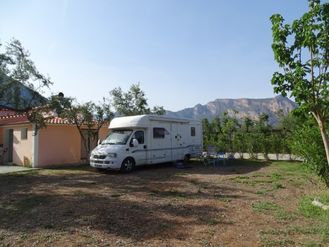 Our pitch next to kitchens in Semeli Camp.
Our pitch next to kitchens in Semeli Camp.
After a quick shop we stopped to rehydrate in a lovely cafe in the town. We were so pleased to see two jolly puppies of about six month’s of age. They were just as we imagined Bozas would grow into. Sadly they ran away before we got a photo of them.
Onwards to the new Semeli Camp in Plaka. It is very pleasant and the staff are charming. Google Translate tells us that:
“According to legend, the ancient name of 'Vrasies' came from the slain Semeli. The earthenware jar in which Zeus trapped Semeli and her son Dionysius as to punish them, was found on the beach of Plaka. The devout citizens of the area decided to honour Semeli with a proper burial but also to take care of the upbringing of Dionysius thus referring him to the tutor Ino. The young tutor protected Dionysius from divine and human forces hiding him in the cave of the current monastery Agios Nikolaos Sytzas. The conquest of the divine beauty of the area fruited a love and euphoria relationship between Dionysius and the land, as a result the crops and fruit multiplied day by day. In honour of Dionysius the plains of the area were named 'The Garden of Dionysius'.
Onwards to the new Semeli Camp in Plaka. It is very pleasant and the staff are charming. Google Translate tells us that:
“According to legend, the ancient name of 'Vrasies' came from the slain Semeli. The earthenware jar in which Zeus trapped Semeli and her son Dionysius as to punish them, was found on the beach of Plaka. The devout citizens of the area decided to honour Semeli with a proper burial but also to take care of the upbringing of Dionysius thus referring him to the tutor Ino. The young tutor protected Dionysius from divine and human forces hiding him in the cave of the current monastery Agios Nikolaos Sytzas. The conquest of the divine beauty of the area fruited a love and euphoria relationship between Dionysius and the land, as a result the crops and fruit multiplied day by day. In honour of Dionysius the plains of the area were named 'The Garden of Dionysius'.
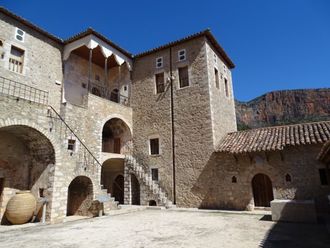 The house of Tsikaliotis, Leonidas.
The house of Tsikaliotis, Leonidas.
21 April 2016, The Queen’s Birthday
While at Semeli camping Judit went for a walk around Plaka and found some ruins of the ancient town of Brasiae. Signposts are at the main road but most of the ruins are on the steep hillside. It is quite difficult to reach. There is another ruin higher up the mountain side but they have to be approached from the other side of the mountain.
After three nights at Semeli we moved just a few kilometers because Judit wanted to look at a special house in Leonidas. It’s named after the owner Tsikaliotis. He built the fortified house in 1808 during the Turkish occupation. All around the house are signs that this was a domestic “fort” with slots in the wall for observing and shooting.
We had to go and have a coffee while we waited for the guide to arrive. She was lovely and very helpful without being over enthusiastic. If you are in Leonidas do visit. It’s very interesting and also free!
From Leonidas we went north up the coast to Astros where we turned west towards Tripoli. We had no trouble with SatNav or paper maps and the scenery was excellent.
At Agios Sostis we turned south to join the Tripoli/Sparti road. Once again the road was in good condition and we enjoyed the ride. In Sparti we drove south down the main street until we found LIDL. For some reason we were low on fresh food.
After LIDL the SatNav started to play games again and we nearly found ourselves in the narrow streets of a housing estate. Luckily we knew the area and decided to ignore the SatNav and drive directly to Camping Paleologio.
We were warmly welcomed by Peter who gave us both a beer which was much appreciated after the long drive.
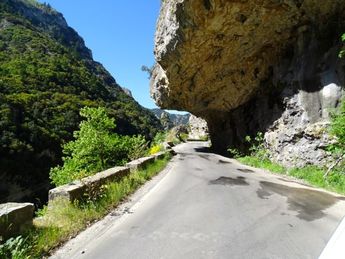 Section of Langada Pass.
Section of Langada Pass.
23 April 2016 Langada Pass
We only stayed one night at the camp. It must be the summer season because Peter charged us €22 for the one night. However we were in a perfect place to approach the Langada Pass which goes from Sparti to Kalamata.
The 59 kilometer long pass is very scenic, which means it has about 30 hairpin bends, deep valleys, steep hills, cliffs overhanging the road and tunnels. One tunnel actually has a Z-bend in it. The summit height is 1,524 meters (about 5,000 feet). But it is not a road to fear because the road is generally quite wide and the roof clearance is good.
We only stayed one night at the camp. It must be the summer season because Peter charged us €22 for the one night. However we were in a perfect place to approach the Langada Pass which goes from Sparti to Kalamata.
The 59 kilometer long pass is very scenic, which means it has about 30 hairpin bends, deep valleys, steep hills, cliffs overhanging the road and tunnels. One tunnel actually has a Z-bend in it. The summit height is 1,524 meters (about 5,000 feet). But it is not a road to fear because the road is generally quite wide and the roof clearance is good.
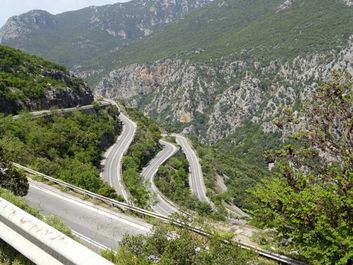 Langada Pass.
Langada Pass.
On the way we passed Tripi and the nearby cliff Keiadas where the ancient Spartans used to throw down any unhealthy babies!
On the downhill side towards Kalamata we stopped for a coffee at a taverna near Artemisia. The water for the coffee came from a spring in the cliffside and was very refreshing.
After two hours driving over the pass with hardly another vehicle in view it was a shock to hit Kalamata. Why is it that everyone in any city has to drive fast? Luckily the Greeks are generally not aggressive when driving, unlike in Italy.
Only one more LIDL before driving to Pylos where we called at the butcher and the greengrocer. It was so nice to be welcomed back by both of them. What a nice place.
On the downhill side towards Kalamata we stopped for a coffee at a taverna near Artemisia. The water for the coffee came from a spring in the cliffside and was very refreshing.
After two hours driving over the pass with hardly another vehicle in view it was a shock to hit Kalamata. Why is it that everyone in any city has to drive fast? Luckily the Greeks are generally not aggressive when driving, unlike in Italy.
Only one more LIDL before driving to Pylos where we called at the butcher and the greengrocer. It was so nice to be welcomed back by both of them. What a nice place.
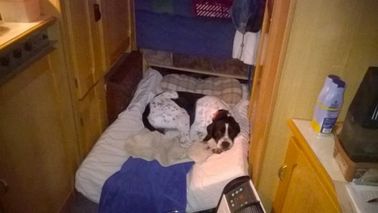 Oscar relaxes on the way to a new owner.
Oscar relaxes on the way to a new owner.
And it was only 30 minutes after that we were in Camping Thines, back in Finikunda. Geoff and Corrie were not there yet so we settled down and relaxed for 2 or 3 days. During that time we walked along the beach to visit Albert, Gabi, and Rod at Camping Finikes where we heard the whole tale of Oscar and his journey to Germany. We were told that he enjoyed his trip to the vet where he was given the works and a new chip to replace his testicles. Then the German lady, who was from an animal sanctuary, took him back to Germany. The original owner would not give his permission for Oscar to leave the country, and we know why. If you let a dog become a stray in Greece there is an €800 fine. But it was too late... he’s gone and according to Albert and Gabi Oscar was very happy to live in a motorhome.
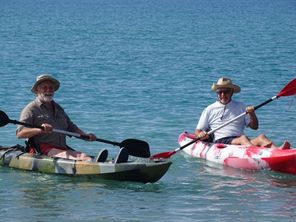 Ian and Geoff enjoying a paddle.
Ian and Geoff enjoying a paddle.
25 April 2016, Arrival
Geoff and Corrie made their appearance today after a few adventures on the way. It was good to see them again after a break of about 3 years. They like Thines camp because it is on the shore and it is handy for their catamaran and the kayaks.
On Good Friday we managed to call home and then went into the village to watch the procession around town. Then we went to Gardenia taverna for a beer and ice cream. We were warmly greeted as friends again by the family.
See Easter in Greece below. It was only on Easter Sunday we were able to play with the kayaks because that day was calm and a smooth sea. Ian and Geoff paddled to Camping Finikes to chat with Albert and Gabi. Ian only managed to get wet once when he capsized landing on the beach. On Easter Monday the weather changed and we had high winds and showers.
Geoff and Corrie made their appearance today after a few adventures on the way. It was good to see them again after a break of about 3 years. They like Thines camp because it is on the shore and it is handy for their catamaran and the kayaks.
On Good Friday we managed to call home and then went into the village to watch the procession around town. Then we went to Gardenia taverna for a beer and ice cream. We were warmly greeted as friends again by the family.
See Easter in Greece below. It was only on Easter Sunday we were able to play with the kayaks because that day was calm and a smooth sea. Ian and Geoff paddled to Camping Finikes to chat with Albert and Gabi. Ian only managed to get wet once when he capsized landing on the beach. On Easter Monday the weather changed and we had high winds and showers.
EASTER IN GREECE
The following notes and some images are taken from several websites including the Greek Reporter, an English language newspaper in Athens.
Easter is one of the most important holidays in the Greek calendar. It commemorates the crucifixion and the resurrection, it also marks the passing of winter to spring.
In Greece, Easter is celebrated with an entire week of festivities; titled The Holy Week – with Good Friday, Easter Sunday, and Easter Monday being public holidays. In Greece, they follow a modified Julian calendar unlike the Gregorian calendar observed by the remainder of the Western world. This means that the two Easters are often up to a month apart. In the UK in 2016 Easter was celebrated on Sunday March 27. In Greece Easter Sunday fell on 1 May.
Easter is one of the most important holidays in the Greek calendar. It commemorates the crucifixion and the resurrection, it also marks the passing of winter to spring.
In Greece, Easter is celebrated with an entire week of festivities; titled The Holy Week – with Good Friday, Easter Sunday, and Easter Monday being public holidays. In Greece, they follow a modified Julian calendar unlike the Gregorian calendar observed by the remainder of the Western world. This means that the two Easters are often up to a month apart. In the UK in 2016 Easter was celebrated on Sunday March 27. In Greece Easter Sunday fell on 1 May.
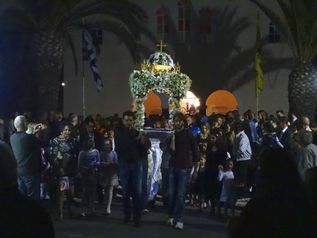 Carrying the bier from Finikunda Church.
Carrying the bier from Finikunda Church.
Good Friday
Good Friday is a sacred day in Greece. The day starts with young girls and women decorating with flowers a replica (or “epitaph”) of Christ’s funeral bier. This is then marched through the streets following an evening mass. There are some areas in Greece that add a twist to the ceremony by burning effigies of Judas Iscariot.
On Good Friday, devout Christians spend the day fasting- meaning they do not eat at all. The atmosphere surrounding the holiday is somber and is one of remembrance and mourning.
Good Friday is a sacred day in Greece. The day starts with young girls and women decorating with flowers a replica (or “epitaph”) of Christ’s funeral bier. This is then marched through the streets following an evening mass. There are some areas in Greece that add a twist to the ceremony by burning effigies of Judas Iscariot.
On Good Friday, devout Christians spend the day fasting- meaning they do not eat at all. The atmosphere surrounding the holiday is somber and is one of remembrance and mourning.
 Holy flame, from Jerusalem, arrives in Athens. Greek Reporter
Holy flame, from Jerusalem, arrives in Athens. Greek Reporter
Easter Saturday
Easter Saturday is known as the The Resurrection or “Anastasis”. Preparations for the dinner begin early in the morning with the cooking of magiritsa- a soup made from lamb offal. The faithful gather at churches before 11 pm, carrying large white candles. Before midnight, the lights of the churches are put out in symbolism of the darkness that Christ had to endure as he passed through the underworld.
At midnight, a priest appears holding a lighted candle taper reciting the phrase “Avto to Fos”, which means “This is the light.” His candle, dubbed “the Holy candle”, is used to light several of the onlookers’ candles, which in turn then light their neighbour’s candles. This continues until the area is lit with candle light. The lighting of the candles is the most significant moment of the entire year.
Easter Saturday is known as the The Resurrection or “Anastasis”. Preparations for the dinner begin early in the morning with the cooking of magiritsa- a soup made from lamb offal. The faithful gather at churches before 11 pm, carrying large white candles. Before midnight, the lights of the churches are put out in symbolism of the darkness that Christ had to endure as he passed through the underworld.
At midnight, a priest appears holding a lighted candle taper reciting the phrase “Avto to Fos”, which means “This is the light.” His candle, dubbed “the Holy candle”, is used to light several of the onlookers’ candles, which in turn then light their neighbour’s candles. This continues until the area is lit with candle light. The lighting of the candles is the most significant moment of the entire year.
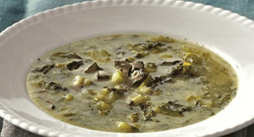 Magiritsa soup
Magiritsa soup
The resurrection is proclaimed at exactly midnight, and is celebrated with drums, fireworks, and church bells. The crowd greet each other with the words “Christós Anésti” (Christ has risen). This is answered with the phrase “Alithós Anésti” (He has truly risen). They then return to their homes to the festive tables and break their fast with the traditional soup, magiritsa (see Recipes). Before entering their homes, they make the symbol of a cross on the door lintel with the smoke of the candle. It is said that if you can make it home without your candle going out, you will have a good year.
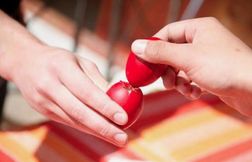 The game of tsougrisma.
The game of tsougrisma.
After the traditional dinner family and friends will crack red eggs. The game symbolizes resurrection and new life. Easter eggs are dyed red to symbolize the blood of Christ. The hard shell of the egg is said to replicate the sealed tomb of Christ. Cracking the egg illustrates the resurrection. The rules of the game, called tsougrisma, are as follows:
Two players select a red egg. Each holds their egg and one taps the end of the other’s egg lightly with theirs. The aim is to crack the other’s egg without being forceful. Once an egg is cracked, the winner uses the same end of their red egg to crack the other end of their opponent’s egg. The winner is said to have good luck all year long.
Two players select a red egg. Each holds their egg and one taps the end of the other’s egg lightly with theirs. The aim is to crack the other’s egg without being forceful. Once an egg is cracked, the winner uses the same end of their red egg to crack the other end of their opponent’s egg. The winner is said to have good luck all year long.
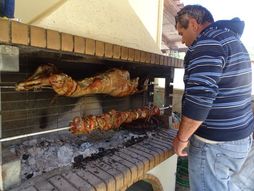 Easter Lamb, Thines Campsite.
Easter Lamb, Thines Campsite.
Easter Sunday
Everyone is up early the next morning to prepare for the Easter Sunday dinner. The most celebrated of the Holy Week, Easter Sunday is a feast of lamb served in honour of the lamb of God. The lamb is usually roasted on a spit outside, and the entire day is celebrated with food, wine, music, friends, and lots of dancing.
Easter Monday is considered to be a day of rest after the week long festivities. People take the day to prepare for the return to work or school. Easter Monday is a public holiday so banks and post offices are closed.
Everyone is up early the next morning to prepare for the Easter Sunday dinner. The most celebrated of the Holy Week, Easter Sunday is a feast of lamb served in honour of the lamb of God. The lamb is usually roasted on a spit outside, and the entire day is celebrated with food, wine, music, friends, and lots of dancing.
Easter Monday is considered to be a day of rest after the week long festivities. People take the day to prepare for the return to work or school. Easter Monday is a public holiday so banks and post offices are closed.
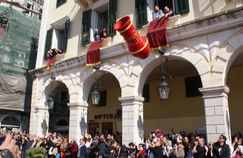 Throwing pots, Crete. Greek Reporter.
Throwing pots, Crete. Greek Reporter.
Greek Easter traditions vary across the country. Here are a few famous affairs that occur during the Easter holidays in different areas around Greece:
Easter in Corfu: On Saturday morning, the “Pot throwing” custom starts the day. Locals throw ceramic pots out of their windows. They believe that by smashing them onto the street below it banishes death and evil spirits. The procession of the holy body of Saint Spyridon also takes place on Holy Saturday. This process was established in 1550, when the Saint saved the island from a famine. His body, which has yet to decompose, is carried throughout the town in the belief that it will perform miracles. On Easter Sunday, churches parade a resurrection icon around the town centre.
The Rocket War of Chios: In Vordados village, 5 km from Chios, rival churches partake in a rocket war, releasing thousands of homemade rockets across town towards each other the night before Easter. The objective is to hit the rival congregation’s bell tower. The tradition supposedly dates back to the Ottoman Empire.
St. George Festival of Arachova: On the second day of Easter, the icon of Saint George is carried throughout the village as the start of a three day festival in his honour. Locals dress in traditional costume and perform a traditional “Panigyraki” dance to bagpipes. The residents then compete in an uphill race for the chance to win a living lamb.
The Saitopolemos of Kalamata: This custom dates back to the revolution fights of 1821. The Kalamatan people used a type of firework (called Saitas) to startle the Turkish horses and help them win the battles. On Easter, men in traditional costume detonate the Saitas, making loud noises.
The Burning of Judas in Metres: Children go door to door the Thursday before Easter collecting sticks to use in the burning of the effigy of Judas Iscariot. The following day, on Good Friday, they light the effigy and proceed to scatter a handful of ashes on tombs.
The Easter Dances of Lerissos: In Lerissos, they relive the “Field of the Doomed Youth”. The elders begin dancing and then invite everyone to join in and hold hands in a dancing circle that can extend up to 400 metres wide. Easter songs continue throughout the day’s celebrations and end with the “Kageleftos” dance. This represents the slaughter of 400 locals by the Ottomans during the revolution. In the Kageleftos dance, dancers pass under an arch of laurel leaves. At the end of the arch are two young men with raised swords.
Easter in Corfu: On Saturday morning, the “Pot throwing” custom starts the day. Locals throw ceramic pots out of their windows. They believe that by smashing them onto the street below it banishes death and evil spirits. The procession of the holy body of Saint Spyridon also takes place on Holy Saturday. This process was established in 1550, when the Saint saved the island from a famine. His body, which has yet to decompose, is carried throughout the town in the belief that it will perform miracles. On Easter Sunday, churches parade a resurrection icon around the town centre.
The Rocket War of Chios: In Vordados village, 5 km from Chios, rival churches partake in a rocket war, releasing thousands of homemade rockets across town towards each other the night before Easter. The objective is to hit the rival congregation’s bell tower. The tradition supposedly dates back to the Ottoman Empire.
St. George Festival of Arachova: On the second day of Easter, the icon of Saint George is carried throughout the village as the start of a three day festival in his honour. Locals dress in traditional costume and perform a traditional “Panigyraki” dance to bagpipes. The residents then compete in an uphill race for the chance to win a living lamb.
The Saitopolemos of Kalamata: This custom dates back to the revolution fights of 1821. The Kalamatan people used a type of firework (called Saitas) to startle the Turkish horses and help them win the battles. On Easter, men in traditional costume detonate the Saitas, making loud noises.
The Burning of Judas in Metres: Children go door to door the Thursday before Easter collecting sticks to use in the burning of the effigy of Judas Iscariot. The following day, on Good Friday, they light the effigy and proceed to scatter a handful of ashes on tombs.
The Easter Dances of Lerissos: In Lerissos, they relive the “Field of the Doomed Youth”. The elders begin dancing and then invite everyone to join in and hold hands in a dancing circle that can extend up to 400 metres wide. Easter songs continue throughout the day’s celebrations and end with the “Kageleftos” dance. This represents the slaughter of 400 locals by the Ottomans during the revolution. In the Kageleftos dance, dancers pass under an arch of laurel leaves. At the end of the arch are two young men with raised swords.
 Judit, Corrie and Geoff in Kalamata.
Judit, Corrie and Geoff in Kalamata.
Getting warmer
Since our arrival at Camping Thines the weather has really warmed up. Naturally we’ve had a couple of days of rain but generally the weather is excellent. Probably the only disturbing weather has been the high winds. This has deterred us from using the kayaks and sometimes the catamaran.
Geoff and Corrie have an excellent inflatable catamaran which has provided us with quite a bit of fun. It certainly brought back the good memories of our old boat back in Hungary.
One day we took Geoff and Corrie to Pylos and another day they took us to Kalamata. It’s the first time we’ve had a good walkabout in the city and found it to be very pleasant. We even found a branch of Praktiker where we looked for hinges. One of the hinges on the “boiler room” door had broken but we could not find a match. They were either too big or too small.
Being closer to Finikunda than before we tended to walk into town. There is a small hill between us and the village that has a killer slope on it. It serves a purpose in that it encourages everyone to stop for a drink once they get to the village.
So all told we had a lovely break back in Finikunda. We met our friends Rose and Alf a few times and look forward to returning to the beautiful bay.
Since our arrival at Camping Thines the weather has really warmed up. Naturally we’ve had a couple of days of rain but generally the weather is excellent. Probably the only disturbing weather has been the high winds. This has deterred us from using the kayaks and sometimes the catamaran.
Geoff and Corrie have an excellent inflatable catamaran which has provided us with quite a bit of fun. It certainly brought back the good memories of our old boat back in Hungary.
One day we took Geoff and Corrie to Pylos and another day they took us to Kalamata. It’s the first time we’ve had a good walkabout in the city and found it to be very pleasant. We even found a branch of Praktiker where we looked for hinges. One of the hinges on the “boiler room” door had broken but we could not find a match. They were either too big or too small.
Being closer to Finikunda than before we tended to walk into town. There is a small hill between us and the village that has a killer slope on it. It serves a purpose in that it encourages everyone to stop for a drink once they get to the village.
So all told we had a lovely break back in Finikunda. We met our friends Rose and Alf a few times and look forward to returning to the beautiful bay.
 Giant Leander at Giannitsochori.
Giant Leander at Giannitsochori.
On the road again
31 May 2016 we said our farewells and began our slow journey towards Hungary. But first stop was to Pylos for a gyros and some shopping at our favourite vegetable shop and our newly found butcher. Naturally we also went to LIDL in Messini for a bit of stocking up.
From LIDL we turned north along the free road that runs alongside the toll road. After about 25 Km we turned west towards the coast and then turned north. Deciding that the day had been a long one we turned down a side road towards the beach at Giannitsochori.
There’s a beach used by the locals and we found a good shade tree in the dunes and had a relaxing evening.
31 May 2016 we said our farewells and began our slow journey towards Hungary. But first stop was to Pylos for a gyros and some shopping at our favourite vegetable shop and our newly found butcher. Naturally we also went to LIDL in Messini for a bit of stocking up.
From LIDL we turned north along the free road that runs alongside the toll road. After about 25 Km we turned west towards the coast and then turned north. Deciding that the day had been a long one we turned down a side road towards the beach at Giannitsochori.
There’s a beach used by the locals and we found a good shade tree in the dunes and had a relaxing evening.
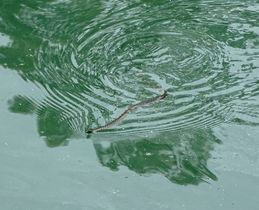 Water snake at Kaiafas Lake.
Water snake at Kaiafas Lake.
Camp Aginara
Several people have told us of a good campsite at Aginara, so we turned that way, driving as near the sea as possible. until we came to Lake Kaiafas. There we went down the east bank of the lake and found the Kaiafas Spring in a cave at the side of the road. It certainly pongs so it must be good for you. In fact only a few hundred meters away is the commercial baths but they looked closed.
The lake is quite pleasant and we saw quite a lot of fish, a few frogs, dragonflies, a water snake and a fisherman. What do the fish taste like after living in sulphurous water?
Next “highlight” was passing Pyrgos. Just like last year the rubbish bags are piled up at the side of the road and look like they have not been collected for months. No idea why Pyrgos is like this.
Palouki was pleasant as was Kourouta and both would make decent night stops in the off-season.
Several people have told us of a good campsite at Aginara, so we turned that way, driving as near the sea as possible. until we came to Lake Kaiafas. There we went down the east bank of the lake and found the Kaiafas Spring in a cave at the side of the road. It certainly pongs so it must be good for you. In fact only a few hundred meters away is the commercial baths but they looked closed.
The lake is quite pleasant and we saw quite a lot of fish, a few frogs, dragonflies, a water snake and a fisherman. What do the fish taste like after living in sulphurous water?
Next “highlight” was passing Pyrgos. Just like last year the rubbish bags are piled up at the side of the road and look like they have not been collected for months. No idea why Pyrgos is like this.
Palouki was pleasant as was Kourouta and both would make decent night stops in the off-season.
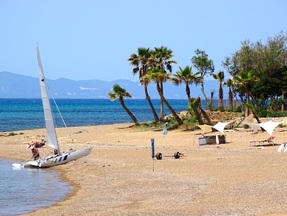 Aginara Beach.
Aginara Beach.
Camp Aginara was easy to find as it is not far from Camp Ionian Beach where we have stayed before. To be honest, Aginara is far nicer. The pitches are clean and large and very well shaded.On top of that is a very good restaurant and a beach bar Perhaps the best part is the beautiful beach with palm trees. It only needs a few monkeys and you would imagine you were on a desert island. The only problem is that the place caters for overweight Germans. All the signs are in German and the staff all speak German.
We stayed a week at Aginara and toured around the area, visiting Chlemoutsi castle and the Roman Baths only a few miles from the camp. Once again it was smelly hot water. Sadly it was very run down and could do with a bit of TLC.
The area is a rich melon growing area and we stopped at the field side and Judit did a deal on a fresh water melon. In fact she was given two melons.
Our stay was brightened by meeting Zita and Paul who were on their first trip to Greece. Thank you for a lovely time. We hope you enjoyed the melon.
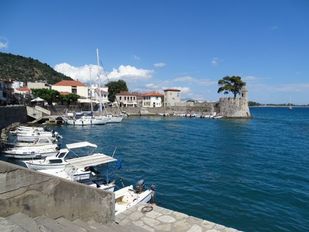 Nafpaktos Harbour.
Nafpaktos Harbour.
Nafpaktos
On the road again. The area also seem to grow lots of large orange pumpkins. There they were stacked up at the side of the road like oranges in a shop.
The pipe for the screen washer had split so we were pleasantly surprise to find a car spares shop next to a filling station in Gastouni. (N 37° 51.417', E 21° 15.477'). We soon sorted out a new pipe and the man insisted on fitting it for all of €2.00.
Soon we were crossing the famous Rio-Antirrio bridge and heading east along the north coast of the Gulf of Corinth. We were heading for a Night Stop not far from the town of Nafpaktos. It was very dusty and dirty next to an abandoned swimming poll and water slides business. However, the other side of the business was a much cleaner pebble beach.
Nafpaktos is quite pleasant but not the best place we have visited. The back streets were interesting as we walked up to the castle and the views were good of the south shore of the Gulf.
On the road again. The area also seem to grow lots of large orange pumpkins. There they were stacked up at the side of the road like oranges in a shop.
The pipe for the screen washer had split so we were pleasantly surprise to find a car spares shop next to a filling station in Gastouni. (N 37° 51.417', E 21° 15.477'). We soon sorted out a new pipe and the man insisted on fitting it for all of €2.00.
Soon we were crossing the famous Rio-Antirrio bridge and heading east along the north coast of the Gulf of Corinth. We were heading for a Night Stop not far from the town of Nafpaktos. It was very dusty and dirty next to an abandoned swimming poll and water slides business. However, the other side of the business was a much cleaner pebble beach.
Nafpaktos is quite pleasant but not the best place we have visited. The back streets were interesting as we walked up to the castle and the views were good of the south shore of the Gulf.
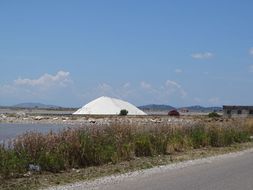 Mounds of salt near Tourlida.
Mounds of salt near Tourlida.
Delphina
Next morning we back tracked a little and took the main road north for some kilometers before turning west to Messolonghi. There we took a left down to the sea once more crossing lagoons and salt pans to Tourlida. It is recommended as a Night Stop and we can see why. There is lots of parking, beaches and three tavernas. When we arrived in June the beaches were full of locals enjoying themselves. We will remember this as a good place to stop for a night.
The town of Messolonghi is famous because Lord Byron died here. His body was shipped back to the UK but his heart is kept here. We followed a few road signs to the memorial but lost them and never did see the memorial.
Next morning we back tracked a little and took the main road north for some kilometers before turning west to Messolonghi. There we took a left down to the sea once more crossing lagoons and salt pans to Tourlida. It is recommended as a Night Stop and we can see why. There is lots of parking, beaches and three tavernas. When we arrived in June the beaches were full of locals enjoying themselves. We will remember this as a good place to stop for a night.
The town of Messolonghi is famous because Lord Byron died here. His body was shipped back to the UK but his heart is kept here. We followed a few road signs to the memorial but lost them and never did see the memorial.
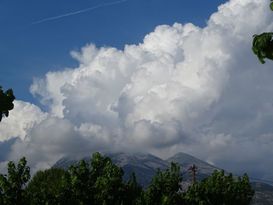 Clouds lurking behind Delphina.
Clouds lurking behind Delphina.
Northward through pleasant scenery to Astakos where there is said to be another Night Stop. To be honest we did not see anywhere we would like to spend a night and so moved on to another recommendation, Restaurant Delphina.
This is down a narrow road to the beach and it really is a taverna with a grassed garden, shade trees and other facilities. Quite pleasant and only €10.00 a night. We chatted to a lovely Dutch couple about the area and our individual plans. It is interesting to note that almost every person we have met has asked us about Brexit. Every person except one said that we should leave and that they also wish to leave the EU. Most people hating the way that poor countries such as Greece have been treated and the way that Germany seems to be trying to take over Europe.
The exception was an elderly German lady who said that the EU stops wars!! We did not have the heart to remind her that Germany started the previous two. And that the EU caused the upsets in the Ukraine. Plus if the EU develops its own army maybe Mr Putin will be upset about the threat to his borders. Poor misguided woman.
This is down a narrow road to the beach and it really is a taverna with a grassed garden, shade trees and other facilities. Quite pleasant and only €10.00 a night. We chatted to a lovely Dutch couple about the area and our individual plans. It is interesting to note that almost every person we have met has asked us about Brexit. Every person except one said that we should leave and that they also wish to leave the EU. Most people hating the way that poor countries such as Greece have been treated and the way that Germany seems to be trying to take over Europe.
The exception was an elderly German lady who said that the EU stops wars!! We did not have the heart to remind her that Germany started the previous two. And that the EU caused the upsets in the Ukraine. Plus if the EU develops its own army maybe Mr Putin will be upset about the threat to his borders. Poor misguided woman.
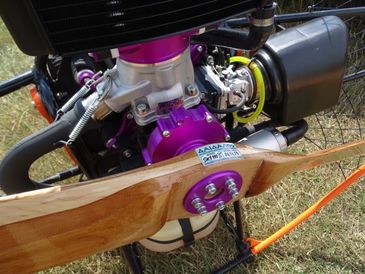 Beautiful paramotor and Greek wooden prop.
Beautiful paramotor and Greek wooden prop.
Mango
The nice Nederlander gave us a few hints about night stops further north. So, following his advice we went north, through the tunnel at Preveza and onwards along the coast road. There we found Mango Beach Experience. It’s really a beach bar, but very well organized. The waiters on the beach among the sunshades and sun beds had two-way radios to call in an order.
We parked on a small cliff with nice views and had a frappe and used the bar’s internet for free. In the evening two guys arrived with Paramotors. Naturally we had a good chat. The motor was Italian two-stroke, the propellor was Greek and the canopy Swiss. From 4,000 to 5000 Euros would buy the lot. The canopies were very good and a landing with a heavy motor on the back was as gentle as stepping down from a kerb. Very impressive.
In fact the paramotor guys and a paraglider chap appeared the following evening and provided a break from the Saturday night disco noises from the bar. It is a sad thought that the next generation are brought up to believe that McDonalds is a restaurant and “music” consists of only a drumbeat... dung, dung, dung,da da, dung. This phrase was repeated for the next 12 hours.
But we had enjoyed a swim in warm water and a club sandwich, free toilets and internet so can’t complain too much. Nevertheless we moved on in the morning to escape from the dung, dung,dung, da da, dung.
The nice Nederlander gave us a few hints about night stops further north. So, following his advice we went north, through the tunnel at Preveza and onwards along the coast road. There we found Mango Beach Experience. It’s really a beach bar, but very well organized. The waiters on the beach among the sunshades and sun beds had two-way radios to call in an order.
We parked on a small cliff with nice views and had a frappe and used the bar’s internet for free. In the evening two guys arrived with Paramotors. Naturally we had a good chat. The motor was Italian two-stroke, the propellor was Greek and the canopy Swiss. From 4,000 to 5000 Euros would buy the lot. The canopies were very good and a landing with a heavy motor on the back was as gentle as stepping down from a kerb. Very impressive.
In fact the paramotor guys and a paraglider chap appeared the following evening and provided a break from the Saturday night disco noises from the bar. It is a sad thought that the next generation are brought up to believe that McDonalds is a restaurant and “music” consists of only a drumbeat... dung, dung, dung,da da, dung. This phrase was repeated for the next 12 hours.
But we had enjoyed a swim in warm water and a club sandwich, free toilets and internet so can’t complain too much. Nevertheless we moved on in the morning to escape from the dung, dung,dung, da da, dung.
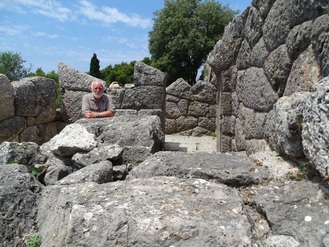 Ian in the labarynth at Necromanteio.
Ian in the labarynth at Necromanteio.
Necromanteio
The next recommendation from the Nederlander was Ammoudia. This is a pleasant little village with a wide and well protected beach. The Germans had got there before us. Along the riverside were about 15 motorhomes and few among the trees near the beach. But first we drove to the next village to look at the ruins of Necromanteio. In brief an oracle lived/worked here. People came along to be “treated” and have their fortunes told. The stonework is very impressive as are the giant jars which in some cases must have been made in-situ because the doorways are too narrow to carry one through.
On our way back to Bessy we stopped for a nibble at the first “snack bar” you find at the crossroads. It’s called Pyli, which means “gate”. The lady of the house is Agnes from Glasgow and she serves a very filling gyros. We enjoyed chatting to her and her husband Trifon before trying to find a spot for the night.
There was shade under the trees, a taverna/store 40 yards away with free wifi and toilets. Lovely. The only disadvantage was that the Germans consider that their dog is also on holiday and they are allowed the run wild around the area.
The next recommendation from the Nederlander was Ammoudia. This is a pleasant little village with a wide and well protected beach. The Germans had got there before us. Along the riverside were about 15 motorhomes and few among the trees near the beach. But first we drove to the next village to look at the ruins of Necromanteio. In brief an oracle lived/worked here. People came along to be “treated” and have their fortunes told. The stonework is very impressive as are the giant jars which in some cases must have been made in-situ because the doorways are too narrow to carry one through.
On our way back to Bessy we stopped for a nibble at the first “snack bar” you find at the crossroads. It’s called Pyli, which means “gate”. The lady of the house is Agnes from Glasgow and she serves a very filling gyros. We enjoyed chatting to her and her husband Trifon before trying to find a spot for the night.
There was shade under the trees, a taverna/store 40 yards away with free wifi and toilets. Lovely. The only disadvantage was that the Germans consider that their dog is also on holiday and they are allowed the run wild around the area.
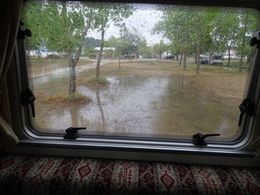 Flooded dunes at Ammoudia.
Flooded dunes at Ammoudia.
Don’t sleep on the damp patch
We had chosen a level spot but it was slightly lower than the surrounding sands. During the night and early morning we had a thunderstorm (the first rain for some time) so we were in a puddle. This seemed to sign that we should roam around the area for a bit of fun. It’s quite pleasant around Ammoudia and we ended up at Pyli snack bar again before spending one more night on the beach. This time on a slightly higher and drier patch.
We had chosen a level spot but it was slightly lower than the surrounding sands. During the night and early morning we had a thunderstorm (the first rain for some time) so we were in a puddle. This seemed to sign that we should roam around the area for a bit of fun. It’s quite pleasant around Ammoudia and we ended up at Pyli snack bar again before spending one more night on the beach. This time on a slightly higher and drier patch.
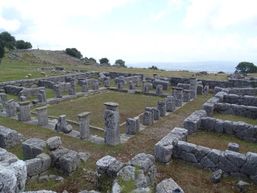 Part of the extensive ruins at Cassope.
Part of the extensive ruins at Cassope.
Cassope and a Castle 14 June 2016
Today was quite busy. First thing was visit Agnes again and have a coffee and make use of the facilities. Next we backtracked towards Preveza, turn east for Archaggelos and north for Kamarina. A couple of kilometers north of the village and uphill are the ruins of Cassope. Parking is alongside the road in the forest and then walk along the cart track to the locked gate... but the fence had been forced open by someone so we went in.
The extensive ruins are of an ancient town and it is very clear to see the layout. The views are wonderful. We saw a nice brown snake about 1 meter long, but it seemed too sleepy to bother us.
Today was quite busy. First thing was visit Agnes again and have a coffee and make use of the facilities. Next we backtracked towards Preveza, turn east for Archaggelos and north for Kamarina. A couple of kilometers north of the village and uphill are the ruins of Cassope. Parking is alongside the road in the forest and then walk along the cart track to the locked gate... but the fence had been forced open by someone so we went in.
The extensive ruins are of an ancient town and it is very clear to see the layout. The views are wonderful. We saw a nice brown snake about 1 meter long, but it seemed too sleepy to bother us.
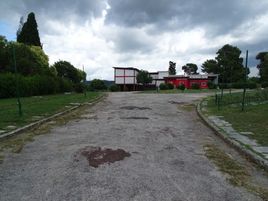 Inside Arta Castle.
Inside Arta Castle.
After a sandwich in the forest we made our way back to the main road and headed for Arta. To be honest Arta is a pain in the Arta. Parking is almost impossible. To get to a car park we had to travel almost the whole way round the town for the opportunity to do a U-turn. One car park said it was for min-buses. It gave the impression “mini buses only”. It was not true so we parked there.
Across the dual carriageway is the castle and it looks very impressive. In the heat of the day we trudged (Ian trudged, Judit walked) to the entrance. The interior was empty except for a very communist era building and signs forbidding access to the ramparts. It took us 3 minutes to decide it was a waste of time.
Despite the set back we meandered a bit around the back streets and even stopped for a cooling frappe at a noisy cafe. There we made the decision to drive north to Ioannina.
Across the dual carriageway is the castle and it looks very impressive. In the heat of the day we trudged (Ian trudged, Judit walked) to the entrance. The interior was empty except for a very communist era building and signs forbidding access to the ramparts. It took us 3 minutes to decide it was a waste of time.
Despite the set back we meandered a bit around the back streets and even stopped for a cooling frappe at a noisy cafe. There we made the decision to drive north to Ioannina.
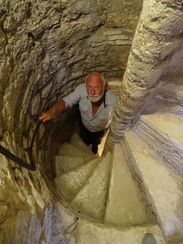 Ian climbs a minaret.
Ian climbs a minaret.
Turkish Delight
We stopped at Limnopoula campsite about 8 year ago. It also had a damp patch, but that time we were travelling with a Land Rover and a tent. We awoke to find ourselves floating on the air bed!
This time the weather continued to be hot and dry so we walked into town and visited the castle. During the Turkish occupation the local big boy was Ali Pasha and he had a great influence on the castle. He built two mosques for a start. People still live inside the castle walls and it is entertaining meandering the narrow streets. One of the mosques houses a museum, including artifacts from of the Jewish life of the town.
We stopped at Limnopoula campsite about 8 year ago. It also had a damp patch, but that time we were travelling with a Land Rover and a tent. We awoke to find ourselves floating on the air bed!
This time the weather continued to be hot and dry so we walked into town and visited the castle. During the Turkish occupation the local big boy was Ali Pasha and he had a great influence on the castle. He built two mosques for a start. People still live inside the castle walls and it is entertaining meandering the narrow streets. One of the mosques houses a museum, including artifacts from of the Jewish life of the town.
 We don't know what it's called!
We don't know what it's called!
The second mosque is also a museum and nearby is the old silversmith workshop containing some lovely examples of their work. There are many paintings of the icon type and the workmanship is fine but Ian considers when you’ve seen one you’ve seen them all.
Back in the busy town we tried to avoid the tourist trap restaurants as we wanted a simple snack. The photographs show what we got. What fun when the waiter does not speak English and we do not speak Greek.
Back in the busy town we tried to avoid the tourist trap restaurants as we wanted a simple snack. The photographs show what we got. What fun when the waiter does not speak English and we do not speak Greek.
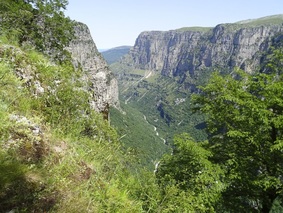 Vikos Gorge.
Vikos Gorge.
Gorge or Canyon
In the morning we drove north from Ioannina to visit Vikos Gorge. Amazingly the roads were in excellent condition with signposts all the way and soon we were in the Pindos mountains. After passing through Monodendri we were travelling through the “stone forest”. The rocks are quite amazing in that they look like flagstones stacked on each other. Only a kilometer later and we were at the end of the road. From there it is a 100 yard walk to a view point of the gorge. The view is outstanding.
According to the Guinness Book of Records, Vikos Gorge is the deepest in the world at a depth of 900 meters (2,950 feet). There is controversy about what constitutes a gorge and what is a canyon. Look it up on the internet. Whatever it is called it's quite a sight.
We left the walled viewpoint and walked along a narrow path for a different view. Not for those who do not like heights with a 2,950 foot drop only inches away. Another feature of the gorge is the range of wildflowers at this height. Very pretty.
In the morning we drove north from Ioannina to visit Vikos Gorge. Amazingly the roads were in excellent condition with signposts all the way and soon we were in the Pindos mountains. After passing through Monodendri we were travelling through the “stone forest”. The rocks are quite amazing in that they look like flagstones stacked on each other. Only a kilometer later and we were at the end of the road. From there it is a 100 yard walk to a view point of the gorge. The view is outstanding.
According to the Guinness Book of Records, Vikos Gorge is the deepest in the world at a depth of 900 meters (2,950 feet). There is controversy about what constitutes a gorge and what is a canyon. Look it up on the internet. Whatever it is called it's quite a sight.
We left the walled viewpoint and walked along a narrow path for a different view. Not for those who do not like heights with a 2,950 foot drop only inches away. Another feature of the gorge is the range of wildflowers at this height. Very pretty.
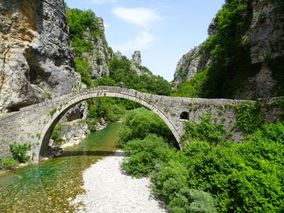 Kokori's Bridge.
Kokori's Bridge.
Back in Monodendri for a snack. This time we were more careful. Ian had goat soup which was delicious. The local sparrows are not shy and were sitting around us waiting for scraps. One even took bread from Ian fingers.
After lunch we walked downhill for about 1 kilometer to the local monastery of Agia Paraskevi. There we had another aspect of the gorge and also the opportunity to be sold icons and such like religious hardware.
Back in Monodendri square we were lathered and really needed a cool drink. The weather has been very hot for about a week now. Today it was 39°C and humid.
The area is certainly very beautiful. Only a few kilometers from Monodendri is a road with old bridges alongside. In the 18th Century local wealthy landowners built the bridges to encourage trade. There are 45 bridges; each one different. Naturally we did not visit all 45 but we were very impressed with the skills and the styles.
After lunch we walked downhill for about 1 kilometer to the local monastery of Agia Paraskevi. There we had another aspect of the gorge and also the opportunity to be sold icons and such like religious hardware.
Back in Monodendri square we were lathered and really needed a cool drink. The weather has been very hot for about a week now. Today it was 39°C and humid.
The area is certainly very beautiful. Only a few kilometers from Monodendri is a road with old bridges alongside. In the 18th Century local wealthy landowners built the bridges to encourage trade. There are 45 bridges; each one different. Naturally we did not visit all 45 but we were very impressed with the skills and the styles.
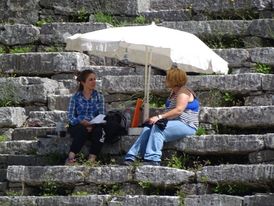 Archeologists at work!
Archeologists at work!
Dodoni
During our Land Rover days we went to Dodoni ruins. It’s another place where oracles foretold the future. In fact it may have been the first in 800 BC. The god dwelt in the roots of a prophetic oak tree. He or she listened to the leaves of the oak tree and customers went away happy!
On our first visit we were not allowed in certain areas because of archeological work. This time nothing appeared to have changed and the archeologists were having a coffee in the amphitheatre. We were still not allowed in to the amphitheatre. Maybe it was too hot!
During our Land Rover days we went to Dodoni ruins. It’s another place where oracles foretold the future. In fact it may have been the first in 800 BC. The god dwelt in the roots of a prophetic oak tree. He or she listened to the leaves of the oak tree and customers went away happy!
On our first visit we were not allowed in certain areas because of archeological work. This time nothing appeared to have changed and the archeologists were having a coffee in the amphitheatre. We were still not allowed in to the amphitheatre. Maybe it was too hot!
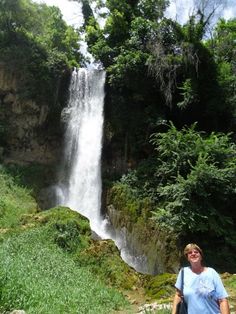 Judit at the largest falls.
Judit at the largest falls.
Cooler Waterfalls
We left Ioannina after negotiating a reduction from the 24 Euro a night to 20 Euro. This is the most expensive campsite we have visited. It’s OK but the wifi does not work and the site is not worth €24.
Now we headed east with our target, Edessa. We used the motorway, Odos Ignatia, and the tolls were quite reasonable for the section we used... about €5.00. Once again the weather was stinking hot and we stopped in the small town of Ptolemaida. The area seems to be rich in coal as a lot of opencast mining was going on.
The young lady in the cafe was very pretty and she also had a VW camper. The photos she showed were excellent. The camper had been repainted in a striking colour scheme. Her and hubby (?) had never been to the Peloponnese so we gave her our card and told here to check the website for places to visit. And the cafe was air conditioned.
Edessa was a pleasant town and had good signposts to the waterfalls. But one or two streets were very narrow and had stone pillars on the footpath edge. We really were millimeters from the pillars and parked cars.
Now the area is very touristy, but still interesting. See the photos. The waterfalls had clearly been around for a long time, but during WWII a German General “removed a cemetery” and made the area more attractive. The old town, or Varosi, is only a hundred meters away and the old houses look very good. When we were there it was throbbing with tourists from other Greek towns. We seemed to be the only foreigners.
We left Ioannina after negotiating a reduction from the 24 Euro a night to 20 Euro. This is the most expensive campsite we have visited. It’s OK but the wifi does not work and the site is not worth €24.
Now we headed east with our target, Edessa. We used the motorway, Odos Ignatia, and the tolls were quite reasonable for the section we used... about €5.00. Once again the weather was stinking hot and we stopped in the small town of Ptolemaida. The area seems to be rich in coal as a lot of opencast mining was going on.
The young lady in the cafe was very pretty and she also had a VW camper. The photos she showed were excellent. The camper had been repainted in a striking colour scheme. Her and hubby (?) had never been to the Peloponnese so we gave her our card and told here to check the website for places to visit. And the cafe was air conditioned.
Edessa was a pleasant town and had good signposts to the waterfalls. But one or two streets were very narrow and had stone pillars on the footpath edge. We really were millimeters from the pillars and parked cars.
Now the area is very touristy, but still interesting. See the photos. The waterfalls had clearly been around for a long time, but during WWII a German General “removed a cemetery” and made the area more attractive. The old town, or Varosi, is only a hundred meters away and the old houses look very good. When we were there it was throbbing with tourists from other Greek towns. We seemed to be the only foreigners.
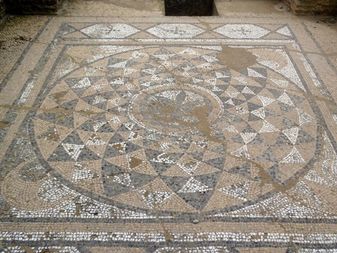 Mosaic at Dion Ruins.
Mosaic at Dion Ruins.
Mount Olympos
Judit decided we should see Olympos and the ruins of Dion. Ian drove. We followed the directions in Lonely Planet and we were there about mid-day. There was a particular aroma around the area that we could not identify. Later we saw signs that this area is famous for growing Kiwi Fruit.
The Dion ruins are quite extensive. We should have avoided the long walk in the heat to look at a house foundations and the Roman theatre. Once we got back to the main area we realised the site was worth visiting. The main street, the adjoining houses and shops, the mosaics were all very attractive and interesting.
After being educated we needed somewhere to stay. We knew that on this coast the campsites are not inspiring and we were not disappointed. We found ourselves in Makedonia camp. When all the others we had passed were full this one was almost empty. We did not need an oracle to tell us something was wrong.
The owner, Nikos, has tried very hard to but not quite managed to make lovely camp. There is a cafe, there are benches, electricity, shade trees, access to a long sandy beach, showers and toilets. One of the toilets was a high type thank goodness. In the evening we decided to allow Nikos to sell us a meal. It was good, with lamb steaks, chips, Greek salad, tsatsiki, etc. The wine was just drinkable. After we sat with Nikos and a Greek family. Nikos plied us with tsipouro. The tsipouro we have had before is made from grape, but this version was the aniseed type. He insisted it was not ouzo. However a large tumbler full is difficult to get down and then it was sneakily refilled. To be honest we had to stay another night to get over the hangover. Smart ploy Nikos.
Judit decided we should see Olympos and the ruins of Dion. Ian drove. We followed the directions in Lonely Planet and we were there about mid-day. There was a particular aroma around the area that we could not identify. Later we saw signs that this area is famous for growing Kiwi Fruit.
The Dion ruins are quite extensive. We should have avoided the long walk in the heat to look at a house foundations and the Roman theatre. Once we got back to the main area we realised the site was worth visiting. The main street, the adjoining houses and shops, the mosaics were all very attractive and interesting.
After being educated we needed somewhere to stay. We knew that on this coast the campsites are not inspiring and we were not disappointed. We found ourselves in Makedonia camp. When all the others we had passed were full this one was almost empty. We did not need an oracle to tell us something was wrong.
The owner, Nikos, has tried very hard to but not quite managed to make lovely camp. There is a cafe, there are benches, electricity, shade trees, access to a long sandy beach, showers and toilets. One of the toilets was a high type thank goodness. In the evening we decided to allow Nikos to sell us a meal. It was good, with lamb steaks, chips, Greek salad, tsatsiki, etc. The wine was just drinkable. After we sat with Nikos and a Greek family. Nikos plied us with tsipouro. The tsipouro we have had before is made from grape, but this version was the aniseed type. He insisted it was not ouzo. However a large tumbler full is difficult to get down and then it was sneakily refilled. To be honest we had to stay another night to get over the hangover. Smart ploy Nikos.
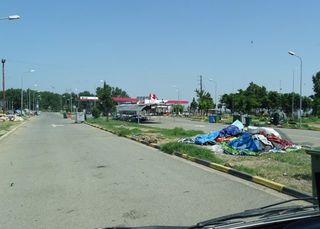 Debris after the immigrants had left.
Debris after the immigrants had left.
Kerkini again
We like it and it's near the Bulgarian border. Eventually with clear heads we decided to visit Kerkini Lake again. Once again a very hot drive. Luckily on the way we found a LIDL near Nea Kavala and also an ATM in the small town of Cherso, where we stopped for a cooling frappe.
Only a few kilometers north we saw a service station and decided that we should top up the diesel. We were shocked to see piles of rubbish that seemed to consist of tents. A team of people were clearing them away after the immigrants had either crossed the border or been taken back to immigration centres. The place was closed so no topping up.
We like it and it's near the Bulgarian border. Eventually with clear heads we decided to visit Kerkini Lake again. Once again a very hot drive. Luckily on the way we found a LIDL near Nea Kavala and also an ATM in the small town of Cherso, where we stopped for a cooling frappe.
Only a few kilometers north we saw a service station and decided that we should top up the diesel. We were shocked to see piles of rubbish that seemed to consist of tents. A team of people were clearing them away after the immigrants had either crossed the border or been taken back to immigration centres. The place was closed so no topping up.
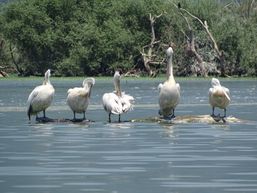 Pelicans on Lake Kerkini.
Pelicans on Lake Kerkini.
Soon we were at Elodia Taverna where we were very warmly welcomed by Xrisa, Aristidis and their daughters Evaggelia and Maroula. They even gave us access to electricity to keep the fridge cool. We were very grateful as the heat was becoming unbearable.
On the 24th we checked the internet for the results of the EU referendum. Brexit is going to happen and the EU politicians are in a panic. Now they will have to start listening to what people want.
Later in the day we took a boat ride on the lake with Theodore. Once again, hundreds of pelicans and other assorted birds. Wonderful place.
For a final evening we had Xrisa’s special moussaka made with buffalo meat. Excellent.
On the 24th we checked the internet for the results of the EU referendum. Brexit is going to happen and the EU politicians are in a panic. Now they will have to start listening to what people want.
Later in the day we took a boat ride on the lake with Theodore. Once again, hundreds of pelicans and other assorted birds. Wonderful place.
For a final evening we had Xrisa’s special moussaka made with buffalo meat. Excellent.
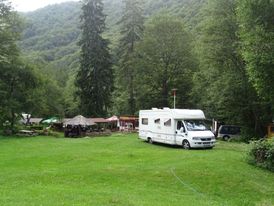 Bor Camp near Rila.
Bor Camp near Rila.
Bulgaria 25 June 2016
Farewell to a lovely family and onwards to Bulgaria. Our side of the border was fairly quiet. But the traffic from Bulgarian to Greece was backed up a very long way. We had a Bulgarian customs man enter Bessy asking if we had any Iraqis and Iranians. Luckily we had none.
The Bulgarian side of the border was chaos, just like Eastern European borders used to be. Small shops with bored shopkeepers, outdated notices telling us where to get a vignette... we knew they were at the Shell Station. Ian went in to buy the vignette and came out with a vignette and a hot dog. Apparently they did not have the correct change so we got a hot dog instead. Interestingly no one at the border area spoke English. In Greece most officials speak some English.
Farewell to a lovely family and onwards to Bulgaria. Our side of the border was fairly quiet. But the traffic from Bulgarian to Greece was backed up a very long way. We had a Bulgarian customs man enter Bessy asking if we had any Iraqis and Iranians. Luckily we had none.
The Bulgarian side of the border was chaos, just like Eastern European borders used to be. Small shops with bored shopkeepers, outdated notices telling us where to get a vignette... we knew they were at the Shell Station. Ian went in to buy the vignette and came out with a vignette and a hot dog. Apparently they did not have the correct change so we got a hot dog instead. Interestingly no one at the border area spoke English. In Greece most officials speak some English.
 Photo from 8-year ago at Bor Camp.
Photo from 8-year ago at Bor Camp.
Still very hot which was not too bad as we were moving. The traffic was horrendous after the quiet roads of Greece but after another 90 minutes we were at Bor Camp near Rila Monastery. Unlike the last time we were here, the sun was shining and the place was packed.
We met a nice young lady from Czech Republic who had been walking in the mountains alone. She had seen nobody the last three days, only horses.
When we were here in June 2008, on our way to meet Pat and Mike in Greece, we took some photos. The people at the campsite were delighted to see them. In fact the boss gave me a bottle of homemade Bulgarian “raki”... that’s something for Richard to look forward to!
We met a nice young lady from Czech Republic who had been walking in the mountains alone. She had seen nobody the last three days, only horses.
When we were here in June 2008, on our way to meet Pat and Mike in Greece, we took some photos. The people at the campsite were delighted to see them. In fact the boss gave me a bottle of homemade Bulgarian “raki”... that’s something for Richard to look forward to!
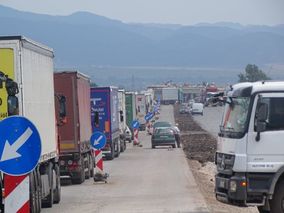 Sofia Ring Road. Under construction for 10 years.
Sofia Ring Road. Under construction for 10 years.
Montana
Monday morning and we are heading north again. Everything went well until we arrived at the Sofia ring road. They still have not finished it and they started before 2008. We were held up for at least one hour at a roundabout. It did not help that the roadworks were going on while the traffic negotiated the roundabout. Great fun but boring and very hot. After the roundabout it was plain sailing all the way. We decided to take a shorter road to Montana because we knew that trucks do not go that way. To be fair it is rather twisty and steep in parts but it is very picturesque. At Montana we had to fill up. One filling station boss checked the exchange rate and took some of our Euros instead of our nonexistent Bulgarian Leva.
Once past Montana we found the route easier than previously because there is a new ring road. It does not go far but it certainly avoids confusing junctions around the town. In about one hour’s time we could see glimpses of the Danube which confirmed we were approaching Vidin. Just before the town is a Truck Stop so we halted and paid the man for one night. He gave us a receipt for €5 and only wanted us to give him €3. Why not?
Monday morning and we are heading north again. Everything went well until we arrived at the Sofia ring road. They still have not finished it and they started before 2008. We were held up for at least one hour at a roundabout. It did not help that the roadworks were going on while the traffic negotiated the roundabout. Great fun but boring and very hot. After the roundabout it was plain sailing all the way. We decided to take a shorter road to Montana because we knew that trucks do not go that way. To be fair it is rather twisty and steep in parts but it is very picturesque. At Montana we had to fill up. One filling station boss checked the exchange rate and took some of our Euros instead of our nonexistent Bulgarian Leva.
Once past Montana we found the route easier than previously because there is a new ring road. It does not go far but it certainly avoids confusing junctions around the town. In about one hour’s time we could see glimpses of the Danube which confirmed we were approaching Vidin. Just before the town is a Truck Stop so we halted and paid the man for one night. He gave us a receipt for €5 and only wanted us to give him €3. Why not?
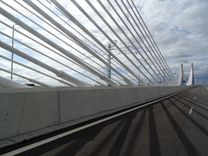 Vidin/Calafat Bridge.
Vidin/Calafat Bridge.
A Bridge Too Late
In the past we have had to take a ferry across the Danube to Calafat in Romania for €75. Now we have been told the EU sponsored bridge is open. Mind you, when it was being constructed it had to be knocked down after 5 year’s work because of poor quality concrete. Once it was built it was of no use because the EU forgot to connect it to border posts with roads. Later there was an EU website that proclaimed there would be another several billion Euro project “to maximise the potential of the Vidin-Calafat bridge”. In other words finish the job!
On the same website was a €4 million Euro project “to encourage Austrian farmers to appreciate their environment”. We have a sneaky feeling that farmers know more about their environment than any Brussels bureaucrat!
In the past we have had to take a ferry across the Danube to Calafat in Romania for €75. Now we have been told the EU sponsored bridge is open. Mind you, when it was being constructed it had to be knocked down after 5 year’s work because of poor quality concrete. Once it was built it was of no use because the EU forgot to connect it to border posts with roads. Later there was an EU website that proclaimed there would be another several billion Euro project “to maximise the potential of the Vidin-Calafat bridge”. In other words finish the job!
On the same website was a €4 million Euro project “to encourage Austrian farmers to appreciate their environment”. We have a sneaky feeling that farmers know more about their environment than any Brussels bureaucrat!
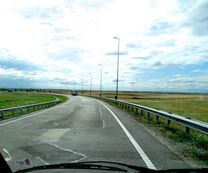 Bridge road collapsing already.
Bridge road collapsing already.
Anyway, we went for the bridge. It is big and also holds a rail track. On the Romanian side of the bridge the road has already started to collapse. Yet another bundle of Euros for someone.
At the border post we had to pay €6 for crossing the bridge (we have paid already with our pensions!) and then another €3 for using the Romanian roads (we have paid already). It looks like they have cheap labour and paper in Romania because it took 15 minutes of bureaucratic computer work and three sheets of A4 paper with several rubber stampings on it. Surely the worker and the paper is worth more than €3. Not much left for new road building (see later).
At the border post we had to pay €6 for crossing the bridge (we have paid already with our pensions!) and then another €3 for using the Romanian roads (we have paid already). It looks like they have cheap labour and paper in Romania because it took 15 minutes of bureaucratic computer work and three sheets of A4 paper with several rubber stampings on it. Surely the worker and the paper is worth more than €3. Not much left for new road building (see later).
 Speeding to the Iron Gate narrows.
Speeding to the Iron Gate narrows.
Iron Gate
After the border the road is in excellent condition and we soon found ourselves at the car park of Pensiunea Danubia. There was one motorhome there already in the car park. Surprisingly he told us to park closer because 18 other motorhomes would arrive later. He was not wrong. The group was being guided around Romania by Dracula Tours.
Luckily the group did not wear lederhosen or start singing strange songs in the evening. In fact the next day the tour guide kindly invited us to join them on a boat ride to see the Iron Gate. We must explain... the Iron Gate is not a gate nor is it made from iron. It is a narrow section of the Danube and is very picturesque.
After the border the road is in excellent condition and we soon found ourselves at the car park of Pensiunea Danubia. There was one motorhome there already in the car park. Surprisingly he told us to park closer because 18 other motorhomes would arrive later. He was not wrong. The group was being guided around Romania by Dracula Tours.
Luckily the group did not wear lederhosen or start singing strange songs in the evening. In fact the next day the tour guide kindly invited us to join them on a boat ride to see the Iron Gate. We must explain... the Iron Gate is not a gate nor is it made from iron. It is a narrow section of the Danube and is very picturesque.
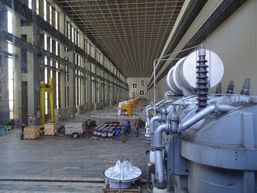 Hydroelectric plant at Danube locks.
Hydroelectric plant at Danube locks.
All the arthritic old pensioners got onto the boats, except one person who used to have a boat but who slipped and bruised his side. Ian is still recovering. There were three boats with powerful 150 horsepower outboards. The drivers gave the impression they were a platoon of Royal Marines attempting a beach landing. The ill-fitting life jackets were appreciated.
After the boat ride we were then invited to join the group on a bus tour to a museum. It soon became clear we had already passed the giant dam and locks on our way from Bulgaria. There were lots of notices that photos were forbidden because it is also a border crossing to Serbia. But we could photograph the photographs of the dam’s construction in the museum for a €5 fee. However we did get a ride down 5 floors in a lift to see the hydroelectric generator room. Not sure if the photos were allowed or not.
After the boat ride we were then invited to join the group on a bus tour to a museum. It soon became clear we had already passed the giant dam and locks on our way from Bulgaria. There were lots of notices that photos were forbidden because it is also a border crossing to Serbia. But we could photograph the photographs of the dam’s construction in the museum for a €5 fee. However we did get a ride down 5 floors in a lift to see the hydroelectric generator room. Not sure if the photos were allowed or not.
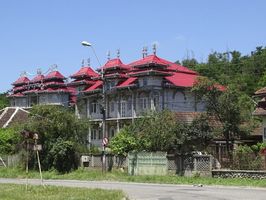 Gypsy King house in Vajdahunyad.
Gypsy King house in Vajdahunyad.
Dracula’s real castle, 30 June 2016
Early in the morning the Germans left for the last day of their tour. We took our time and pointed north in Arad direction then turned right at Caransebes towards Hateg. There we turned north again on a winding road to Hunedoara (or Vajdahunyad in Hungarian).
On the outskirts of town we saw about a dozen Gypsy King houses with UK registered cars outside. Draw your own conclusions.
The town is quite pleasant but the important feature is a magnificent castle. Ian always says that old castles look better from the outside. In this case it looked very good inside as well.
Early in the morning the Germans left for the last day of their tour. We took our time and pointed north in Arad direction then turned right at Caransebes towards Hateg. There we turned north again on a winding road to Hunedoara (or Vajdahunyad in Hungarian).
On the outskirts of town we saw about a dozen Gypsy King houses with UK registered cars outside. Draw your own conclusions.
The town is quite pleasant but the important feature is a magnificent castle. Ian always says that old castles look better from the outside. In this case it looked very good inside as well.
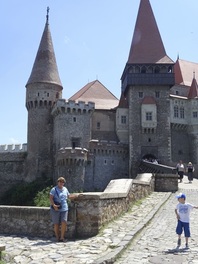 The magnificent castle at Vajdahunyad.
The magnificent castle at Vajdahunyad.
The Romanian tour guide for the Germans assured us there is documentary evidence that Dracula actually lived here; unlike the place where most tourists flock to. Most of the castle was original and other parts had been thoughtfully restored. There were life-size dummies in the prison, a man playing a lute-like instrument in one room accompanying a dancer in costume and in the torture chamber a real live torturer in costume. It was very good indeed without being Disney-like.
About 6 mile to the south of town is Cincis Lake where we found Ledo Camping. It is a very well run lakeside camp that has awful French toilets. Our neighbours were a Romanian couple who spoke excellent English and gave us some local advice. Very kind.
Later two more campers arrived which made the small “camper van” area quite crowded.
About 6 mile to the south of town is Cincis Lake where we found Ledo Camping. It is a very well run lakeside camp that has awful French toilets. Our neighbours were a Romanian couple who spoke excellent English and gave us some local advice. Very kind.
Later two more campers arrived which made the small “camper van” area quite crowded.
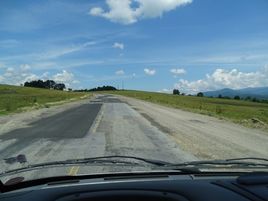 A small section of "roadworks".
A small section of "roadworks".
Road to Ruin
Next stop was Lidl in Hunedoara/Vajdahunyad and then the road north to an area we know from our Land Rover days. Simple route just follow the E74 for over 100 miles. The whole route was a disaster with half the road dug down to 6 feet and the other half for driving on. Every few kilometers there were sections controlled by traffic lights to enable us to pass the roadworks. The unprepared half was an awful mixture of tarmac and dirt with potholes every few yards. Every kilometer or so was a new culvert under the road but the top was at the anticipated height of the new road to be. That meant a bump of about one meter. Each side had dirt piled against the culvert to make it easy for us. To be honest we would probably have been better going via Albania.
Bessy was so shaken around that the “boiler room” door lost a hinge, the sliding bathroom door became damaged at the runners and one of the drawers broke a lock. We also have a feeling that the constant velocity joint of the front right wheel is damaged.
We took some photos and then gave up as it was just the same for the next 4 hours.
Next stop was Lidl in Hunedoara/Vajdahunyad and then the road north to an area we know from our Land Rover days. Simple route just follow the E74 for over 100 miles. The whole route was a disaster with half the road dug down to 6 feet and the other half for driving on. Every few kilometers there were sections controlled by traffic lights to enable us to pass the roadworks. The unprepared half was an awful mixture of tarmac and dirt with potholes every few yards. Every kilometer or so was a new culvert under the road but the top was at the anticipated height of the new road to be. That meant a bump of about one meter. Each side had dirt piled against the culvert to make it easy for us. To be honest we would probably have been better going via Albania.
Bessy was so shaken around that the “boiler room” door lost a hinge, the sliding bathroom door became damaged at the runners and one of the drawers broke a lock. We also have a feeling that the constant velocity joint of the front right wheel is damaged.
We took some photos and then gave up as it was just the same for the next 4 hours.
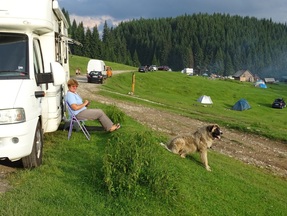 Judit's new friend. Look at the size!
Judit's new friend. Look at the size!
Padis surprise
We have been told that the road into the mountains at Padis has been asphalted. In our Land Rover days the road was dirt and rock and took over one hour to ascend into the mountains. Surprise, surprise the road HAS been repaired. It is probably the best road in Romania. But it is still quite a climb over a distance of 23 kilometers to a height of 1350 meters (4,430 feet in real money).
The second surprise was the development that has taken place. When we used to go there for “Rescue Practice” in early May there was a grassy area with a gentle stream running through the middle of the valley. Now there are 4 or 5 permanent snack bars and even a resident Romanian Mountain Rescue Team with their own huts. It was difficult to find a level area to park. We kept clear of the wet sloping grass and parked for two nights at the side of the unsurfaced road. The road is not muddy as it has been stoned. It is rough but passable with care.
We have been told that the road into the mountains at Padis has been asphalted. In our Land Rover days the road was dirt and rock and took over one hour to ascend into the mountains. Surprise, surprise the road HAS been repaired. It is probably the best road in Romania. But it is still quite a climb over a distance of 23 kilometers to a height of 1350 meters (4,430 feet in real money).
The second surprise was the development that has taken place. When we used to go there for “Rescue Practice” in early May there was a grassy area with a gentle stream running through the middle of the valley. Now there are 4 or 5 permanent snack bars and even a resident Romanian Mountain Rescue Team with their own huts. It was difficult to find a level area to park. We kept clear of the wet sloping grass and parked for two nights at the side of the unsurfaced road. The road is not muddy as it has been stoned. It is rough but passable with care.
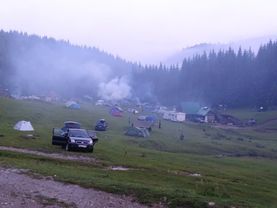 Evening wood smoke.
Evening wood smoke.
Now it is Summer the area was littered with tents and jolly walking types. In the evenings the whole valley filled with wood smoke from the many open fires. Then the shepherds heading home with their flocks came through the camp. The flocks were guarded by Caucasian sheepdogs or variations on that theme. These dogs are huge and not to be tangled with. Luckily three or four decided that Bessy provided good shade and we had two resident underneath the chassis.
One evening four cows walked by and we enjoyed watching them have a good nose in and around the tents.
On our second day we walked a few kilometers up and down the tracks to another valley. It has an interesting feature in that the stream has a couple of holes which drain the stream causing whirlpools. However the water was very low and the whirlpools were not visible. We have seen the valley almost filled with water in May.
One evening four cows walked by and we enjoyed watching them have a good nose in and around the tents.
On our second day we walked a few kilometers up and down the tracks to another valley. It has an interesting feature in that the stream has a couple of holes which drain the stream causing whirlpools. However the water was very low and the whirlpools were not visible. We have seen the valley almost filled with water in May.
Hot Water. Sunday 3 July 2016
By leaving early we avoided the Sunday evening traffic descending the mountain. Once at the main road we had a few more kilometers of rough road again until we got to Salonta. We used up the last of our Romanian Lei by topping up the diesel at the OMV station.
Just a couple of hundred meters further and we took the road to the right to the border. The road is absolutely straight for 13 miles, through the border to Sarkad, which literally translates as “your heel”.
The famous Hungarian anti-immigrant fence was well hidden but the border officials wanted to see all our documents and to examine the inside of Bessy for immigrants.
By leaving early we avoided the Sunday evening traffic descending the mountain. Once at the main road we had a few more kilometers of rough road again until we got to Salonta. We used up the last of our Romanian Lei by topping up the diesel at the OMV station.
Just a couple of hundred meters further and we took the road to the right to the border. The road is absolutely straight for 13 miles, through the border to Sarkad, which literally translates as “your heel”.
The famous Hungarian anti-immigrant fence was well hidden but the border officials wanted to see all our documents and to examine the inside of Bessy for immigrants.
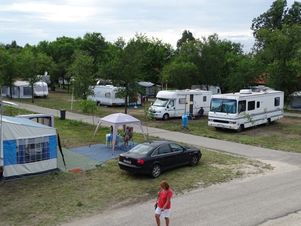 Cserkeszölö Thermal Camp.
Cserkeszölö Thermal Camp.
From the border the road is in much better condition... not perfect by any means, but much better. We skirted Gyula and Bekescsaba, and soon we were at the River Tisza. Our newish map showed a couple of campsites around the banks of the river but we could see no sign of them. That meant we should backtrack for a few miles to Cserkeszölö where there is a camp at a thermal spring.
The camp is very well appointed and is directly next to the hot water. In fact the entrance fee for the camp also gives you access to the waters. So after getting sorted we changed into our cozzies and had a sit in hot water. There are several different pools and the whole project is very professional. Hundreds of people were enjoying splashing around or just sitting in the murky water, curing everything from gynaecological complaints, orthopaedic problems, skin conditions to rheumatism. They even have a “salt chamber” where you can relieve your pulmonary complaints. At the same time they have a “Krioszauna” where a cold room can also cure your rheumatism, etc.
The camp is very well appointed and is directly next to the hot water. In fact the entrance fee for the camp also gives you access to the waters. So after getting sorted we changed into our cozzies and had a sit in hot water. There are several different pools and the whole project is very professional. Hundreds of people were enjoying splashing around or just sitting in the murky water, curing everything from gynaecological complaints, orthopaedic problems, skin conditions to rheumatism. They even have a “salt chamber” where you can relieve your pulmonary complaints. At the same time they have a “Krioszauna” where a cold room can also cure your rheumatism, etc.
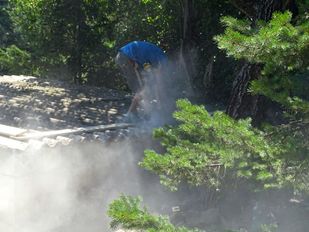 Asbestos dust cloud.
Asbestos dust cloud.
Balatonalmadi again, 4 July 2016
After signing out around 10-00 am we continued westward, skirting Kecskemét before crossing the Danube at Dunaföldvár. At Enying we found another Lidl and so stocked up for a couple of days. Soon after Lake Balaton came into view and before long we were parked up at the weekend house. Time to relax, wish Richard a Happy Birthday, then go to the local DIY shop for hinges and screws.
Incidentally we employed a team to repair the asbestos garage roof. It would appear that Health and Safety is not too important in Hungary. Look at the photo of the young man using an angle grinder on the roof.
After signing out around 10-00 am we continued westward, skirting Kecskemét before crossing the Danube at Dunaföldvár. At Enying we found another Lidl and so stocked up for a couple of days. Soon after Lake Balaton came into view and before long we were parked up at the weekend house. Time to relax, wish Richard a Happy Birthday, then go to the local DIY shop for hinges and screws.
Incidentally we employed a team to repair the asbestos garage roof. It would appear that Health and Safety is not too important in Hungary. Look at the photo of the young man using an angle grinder on the roof.
Repairs
Our run through Romania had not done Bessy any favours. The sliding door of the toilet had sagged because of the weight on the runners at the top. The “boiler room” door had broken a hinge. The fridge refused to work on gas and the toilet would not flush.
Fortunately we found a caravan sales-and-service place at Balatonfüzfö, which is at the northern end of Lake Balaton just a few miles from our base at Almadi. We made an appointment with a very nice man and they investigated why the gas part of the fridge is not working. Would you believe it was an extended family of spiders blocking the jets. We were charged for one hours work at £16.00. Around 20% of the UK price... at least.
While waiting we had a good look at the shop. They seem to have everything a motorhomer could need.
Váradi Caravan
Address: 8175 Balatonfűzfő, Árpád u. 7.
Email: [email protected]
Website: http://varadicaravan.hu/
Coordinates: N 47° 4.070', E 18° 2.263'
Our run through Romania had not done Bessy any favours. The sliding door of the toilet had sagged because of the weight on the runners at the top. The “boiler room” door had broken a hinge. The fridge refused to work on gas and the toilet would not flush.
Fortunately we found a caravan sales-and-service place at Balatonfüzfö, which is at the northern end of Lake Balaton just a few miles from our base at Almadi. We made an appointment with a very nice man and they investigated why the gas part of the fridge is not working. Would you believe it was an extended family of spiders blocking the jets. We were charged for one hours work at £16.00. Around 20% of the UK price... at least.
While waiting we had a good look at the shop. They seem to have everything a motorhomer could need.
Váradi Caravan
Address: 8175 Balatonfűzfő, Árpád u. 7.
Email: [email protected]
Website: http://varadicaravan.hu/
Coordinates: N 47° 4.070', E 18° 2.263'
Bog Off
Ian managed to repair the toilet flushing problem. We have a Thetford C200 toilet. Being the electric flushing model it is a “C200 CWE”. First he had a look at the fuse which is in the cassette locker on the left. It’s pink and a bugger to pull out without losing finger nails. But the fuse was OK.
Next was a look at the actual pump. According to the internet a dried out or clagged up pump is the most common problem. Much easier to repair than you would imagine.
First of all remove the panel holding the flushing button. Luckily it is not a “click fit”. Just get a dining knife and wiggle it under the edges. The panel is held down with grey mastic and comes away quite easily.
Next remove the panel underneath which is held by four screws. Do not drop them into the cistern or the pot!
Then put your hand down into the water tank and feel for the pump. It is about 12 cm long and about 4 cm diameter. It’s blue and has various wires and pipes attached. Do NOT remove them. Simply wiggle the pump up into fresh air. On one end you can see the spindle of the pump. Grab it with some thin nosed pliers and turn the spindle a few turns.
Try the pump. If working replace in reverse order. If not look at the Thetford videos or take it to Mr Váradi.
15 minutes job at the most. Ian did not have any narrow mastic so used a few blobs of bathroom sealant for the outer cover.
The Thetford website has several pages devoted to repairs of toilets, etc but it is a bit of a bugger to find them. Here are the links for the C200 type toilet: http://www.thetford-europe.com/download-product/c200/
Ian managed to repair the toilet flushing problem. We have a Thetford C200 toilet. Being the electric flushing model it is a “C200 CWE”. First he had a look at the fuse which is in the cassette locker on the left. It’s pink and a bugger to pull out without losing finger nails. But the fuse was OK.
Next was a look at the actual pump. According to the internet a dried out or clagged up pump is the most common problem. Much easier to repair than you would imagine.
First of all remove the panel holding the flushing button. Luckily it is not a “click fit”. Just get a dining knife and wiggle it under the edges. The panel is held down with grey mastic and comes away quite easily.
Next remove the panel underneath which is held by four screws. Do not drop them into the cistern or the pot!
Then put your hand down into the water tank and feel for the pump. It is about 12 cm long and about 4 cm diameter. It’s blue and has various wires and pipes attached. Do NOT remove them. Simply wiggle the pump up into fresh air. On one end you can see the spindle of the pump. Grab it with some thin nosed pliers and turn the spindle a few turns.
Try the pump. If working replace in reverse order. If not look at the Thetford videos or take it to Mr Váradi.
15 minutes job at the most. Ian did not have any narrow mastic so used a few blobs of bathroom sealant for the outer cover.
The Thetford website has several pages devoted to repairs of toilets, etc but it is a bit of a bugger to find them. Here are the links for the C200 type toilet: http://www.thetford-europe.com/download-product/c200/
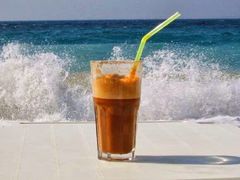 Greek Frappe.
Greek Frappe.
Summer in Hungary 2016
Funny Frappe
We arrived in our Summer Retreat of Balatonalmadi on 4 July. The first problem we encountered was a leaking water boiler... it was 50 years old anyway. The second problem was not as serious. Judit’s sister arrived and Ian decided to make a Greek Frappe.
While we were in Kerkini in Greece we were told that we could make our own frappe with a mains driven whizzer which is available at most supermarkets. Sure enough even the small shop in Kerkini had one.., about €10. This was our first opportunity to use the new whizzer.
Before that Ian had read closely how to do the deed.
All went well except the froth came almost to the top of the glass. Thinks: did Ian whizz too much?
But he carried on and eventually finished with the cold water.
The "enjoy" part was unusual. It turned out that Ian had mistaken the cold water bottle for a bottle of fizzy lemonade. Hence the froth all the way to the top.
Funnily enough it was not unpleasant but we will not repeat the mistake
Funny Frappe
We arrived in our Summer Retreat of Balatonalmadi on 4 July. The first problem we encountered was a leaking water boiler... it was 50 years old anyway. The second problem was not as serious. Judit’s sister arrived and Ian decided to make a Greek Frappe.
While we were in Kerkini in Greece we were told that we could make our own frappe with a mains driven whizzer which is available at most supermarkets. Sure enough even the small shop in Kerkini had one.., about €10. This was our first opportunity to use the new whizzer.
Before that Ian had read closely how to do the deed.
- 1. one or two spoons of Nescafe Original into a tall glass
- 2. As much or as little sugar as desired
- 3. No more than 1.5 cm of very cold water into the glass.
- 4. Whizz the mixture until it becomes very stiff. In fact you should be able to turn the glass upside down without the froth coming out.
- 5. Drop into the glass a few ice cubes
- 6. Pour a little milk down the side of the froth
- 7. Pour cold water down the side of the froth to fill the glass
- 8. Sit down for a couple of hours and enjoy.
All went well except the froth came almost to the top of the glass. Thinks: did Ian whizz too much?
But he carried on and eventually finished with the cold water.
The "enjoy" part was unusual. It turned out that Ian had mistaken the cold water bottle for a bottle of fizzy lemonade. Hence the froth all the way to the top.
Funnily enough it was not unpleasant but we will not repeat the mistake
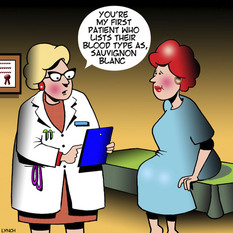
Budapest Blood
Our GP in the UK is very keen on sending Ian for blood tests. As it involves going to the surgery to collect the forms, then going home because the hospital would be closed. Next day go to hospital on two bus rides. Sit around for an hour and then take two buses home again. Plus never getting told the results !
Ian came up with a cunning plan.
While we were in Budapest for a couple of days he went to a private clinic and had a full blood test. Results by email within 24 hours. Now when the GP suggests yet more blood tests Ian can present the complete set. Wait for further news.
Incidentally the full blood test came to about £10. How much is it costing in the UK? Especially if you take into account the hundreds of patients and their bus journeys plus being away from work for a morning. Don't forget parking at a hospital.
In the old days a GP would take the blood sample and a man in a van would tour all the GP surgeries to collect the samples and return with the results. Much more efficient.
Our GP in the UK is very keen on sending Ian for blood tests. As it involves going to the surgery to collect the forms, then going home because the hospital would be closed. Next day go to hospital on two bus rides. Sit around for an hour and then take two buses home again. Plus never getting told the results !
Ian came up with a cunning plan.
While we were in Budapest for a couple of days he went to a private clinic and had a full blood test. Results by email within 24 hours. Now when the GP suggests yet more blood tests Ian can present the complete set. Wait for further news.
Incidentally the full blood test came to about £10. How much is it costing in the UK? Especially if you take into account the hundreds of patients and their bus journeys plus being away from work for a morning. Don't forget parking at a hospital.
In the old days a GP would take the blood sample and a man in a van would tour all the GP surgeries to collect the samples and return with the results. Much more efficient.
Bessy’s joints
On the very rare occasion when we take a full lock turn with the outer wheel going over a hump we hear a grating noise. To be honest it sounds like the mud flap is rubbing the tyre. But to be safe we went to the Fiat dealer in Veszprem. He was unable to help us because he does not have a lift strong enough to lift Bessy. Does he not have a jack and suitable axle stands?
So we went down the road to a truck garage. They deal with all the trucks for a couple of freight companies. The two men spent over one hour under Bessy using all sorts of wobbling plates and other torture devices that gave the suspension a real workout. We were invited under Bessy to see that there really was nothing wrong to be found with the front end of the old girl. Cost: nil!
On the very rare occasion when we take a full lock turn with the outer wheel going over a hump we hear a grating noise. To be honest it sounds like the mud flap is rubbing the tyre. But to be safe we went to the Fiat dealer in Veszprem. He was unable to help us because he does not have a lift strong enough to lift Bessy. Does he not have a jack and suitable axle stands?
So we went down the road to a truck garage. They deal with all the trucks for a couple of freight companies. The two men spent over one hour under Bessy using all sorts of wobbling plates and other torture devices that gave the suspension a real workout. We were invited under Bessy to see that there really was nothing wrong to be found with the front end of the old girl. Cost: nil!
Relaxing
In Tesco at Veszprem is a store selling knives. Many of them would not be allowed into the UK. However the man also had a good selection of whetstones. Two of these kept Ian amused for hours sharpening our knives. We’ve had a full set of quality kitchen knives for over 20 years and have only ever had the steel on them to keep them sharp. However a few minutes on the whetstones really put an edge on them. Even the ones in the house that have been there for 50 years came up a treat. Well worth the investment and very relaxing.
In Tesco at Veszprem is a store selling knives. Many of them would not be allowed into the UK. However the man also had a good selection of whetstones. Two of these kept Ian amused for hours sharpening our knives. We’ve had a full set of quality kitchen knives for over 20 years and have only ever had the steel on them to keep them sharp. However a few minutes on the whetstones really put an edge on them. Even the ones in the house that have been there for 50 years came up a treat. Well worth the investment and very relaxing.
Weather
During the summer Hungary gets its fair share of thunderstorms. During our stay of two months we suffered 13 dramatic thunderstorms and 19 rainy days. One storm occurred while we were on a train returning from Budapest. The driver had to stop because of poor visibility. Looking out of the windows we could not see the ground as the rain was so heavy. Yorkshire Day (August 1st) was nice and cool but we did have a storm in the evening. However the temperature never dropped below 23 during the day; usually it was around 30 degrees. This year has not had a serious heatwave because we have never had to switch the fan on.
During the summer Hungary gets its fair share of thunderstorms. During our stay of two months we suffered 13 dramatic thunderstorms and 19 rainy days. One storm occurred while we were on a train returning from Budapest. The driver had to stop because of poor visibility. Looking out of the windows we could not see the ground as the rain was so heavy. Yorkshire Day (August 1st) was nice and cool but we did have a storm in the evening. However the temperature never dropped below 23 during the day; usually it was around 30 degrees. This year has not had a serious heatwave because we have never had to switch the fan on.
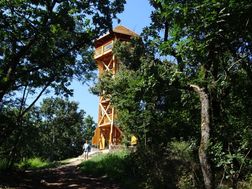 Lookout tower at Alsoörs.
Lookout tower at Alsoörs.
Lookout Towers
We rented a small car for a very good price and enjoyed looking down narrow roads that would not be good in Bessy. The North side of Lake Balaton is very picturesque especially if you move away from the lake. We were able to visit several of the lookout towers.
Someone must have negotiated a good contract with the government! On almost every hill overlooking Lake Balaton is a Lookout Tower. To be honest they are well made and give a great view. Though on some of the hills it would have been much cheaper to just chop down a couple of bushes to see the view.
We rented a small car for a very good price and enjoyed looking down narrow roads that would not be good in Bessy. The North side of Lake Balaton is very picturesque especially if you move away from the lake. We were able to visit several of the lookout towers.
Someone must have negotiated a good contract with the government! On almost every hill overlooking Lake Balaton is a Lookout Tower. To be honest they are well made and give a great view. Though on some of the hills it would have been much cheaper to just chop down a couple of bushes to see the view.
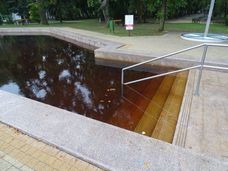 Healthy water.
Healthy water.
Small Tour of the Hungarian Plain
Off we went in Bessy for a few days meandering around the flat centre of Hungary. And it is flat. Holland is flat but the great plain of Hungary has so little vegetation and villages it “feels” flatter. We should mention that flat does not mean smooth. Once away from Balaton and Budapest the roads were terrible with many potholes and collapsed sections.
Our first stop was Törökszentmiklós after driving all the way in wind and rain. There we found a campsite and thermal baths. Amazingly we found ourselves in an almost deserted campsite... only one other vehicle. But we had electric, water, showers and so on. In the morning we had a quick splash in the dark brown water. Luckily it did not smell of sulphur as so many do.
Off we went in Bessy for a few days meandering around the flat centre of Hungary. And it is flat. Holland is flat but the great plain of Hungary has so little vegetation and villages it “feels” flatter. We should mention that flat does not mean smooth. Once away from Balaton and Budapest the roads were terrible with many potholes and collapsed sections.
Our first stop was Törökszentmiklós after driving all the way in wind and rain. There we found a campsite and thermal baths. Amazingly we found ourselves in an almost deserted campsite... only one other vehicle. But we had electric, water, showers and so on. In the morning we had a quick splash in the dark brown water. Luckily it did not smell of sulphur as so many do.
 Choose your water treatment.
Choose your water treatment.
Next day was much brighter and we drove on to Hajdúszoboszló where there is a large Aquapark. According to the locals it is the largest in Europe and we can believe it.
The main theme is to sit in brown, slightly smelly water and become healthy. You can visit a doctor and be directed to the best treatment. We quote:
“This medicinal water can mainly help to recover rheumatic ills. The cure is effective for those suffering from chronic locomotor disorders, degenerative illnesses and locomotor disorders of surgical, neurological, internal and dermatological origins. Patients having gone through orthopaedic operations return regularly to get follow-up treatments. We have also achieved good results with patients recovering from cerebral haemorrhage or paralyses following the Heine-Medin illness as well as with treatment for chronic neuralgia and neuritis stenoses and leg ulcers often start to heal as a result of the treatment.
The water has a good effect upon gynaecological inflammation, too. After two or three cures a year childless, infertile women could become pregnant on several occasions. This is explained by the oestrogen, which is found in the water.
The rheumatologists of the spa work under the supervision of head physician Dr. Mihály Oláh.”
And to think Ian always thought skin was waterproof!
The main theme is to sit in brown, slightly smelly water and become healthy. You can visit a doctor and be directed to the best treatment. We quote:
“This medicinal water can mainly help to recover rheumatic ills. The cure is effective for those suffering from chronic locomotor disorders, degenerative illnesses and locomotor disorders of surgical, neurological, internal and dermatological origins. Patients having gone through orthopaedic operations return regularly to get follow-up treatments. We have also achieved good results with patients recovering from cerebral haemorrhage or paralyses following the Heine-Medin illness as well as with treatment for chronic neuralgia and neuritis stenoses and leg ulcers often start to heal as a result of the treatment.
The water has a good effect upon gynaecological inflammation, too. After two or three cures a year childless, infertile women could become pregnant on several occasions. This is explained by the oestrogen, which is found in the water.
The rheumatologists of the spa work under the supervision of head physician Dr. Mihály Oláh.”
And to think Ian always thought skin was waterproof!
Some of the treatments:
Mud treatment
Underwater jet massage
Iontophorese
Sollux
Ultrasound
Interference
Diadinamic
Electric personal bath divided
Refreshing massage
Sole massage
Aromatic oil foot reflex massage
Complex relaxation massage (foot, body, head)
Face, neck and decollete massage
Head and ear massage
Bamboo massage
Coffee massage from Colombia
Honey massage from Tibet
Aztec chocolate pack with peeling
Dead marine silt pack (peeling, silt pack, foot massage)
Coffee pack
Exotic silk pack
Regeneration after birth
Ian wondered if it would be possible to combine “Interference” with the “Chocolate”.
Mud treatment
Underwater jet massage
Iontophorese
Sollux
Ultrasound
Interference
Diadinamic
Electric personal bath divided
Refreshing massage
Sole massage
Aromatic oil foot reflex massage
Complex relaxation massage (foot, body, head)
Face, neck and decollete massage
Head and ear massage
Bamboo massage
Coffee massage from Colombia
Honey massage from Tibet
Aztec chocolate pack with peeling
Dead marine silt pack (peeling, silt pack, foot massage)
Coffee pack
Exotic silk pack
Regeneration after birth
Ian wondered if it would be possible to combine “Interference” with the “Chocolate”.
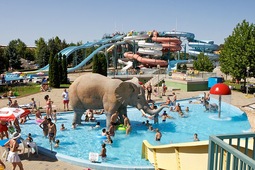 Aquapark at Hajdúszoszló
Aquapark at Hajdúszoszló
However the other part of the area is taken up with having fun. There are pools that bubble, pools where the water moves like a river, pools where waves form and so on.
And when you have become healthy you can visit the many cafes selling burgers, pizzas and chips.
The real fun part is the area devoted to water slides. However they are NOT included in the cost of the campsite. Being a good Yorkshireman Ian decided not to bother.
And when you have become healthy you can visit the many cafes selling burgers, pizzas and chips.
The real fun part is the area devoted to water slides. However they are NOT included in the cost of the campsite. Being a good Yorkshireman Ian decided not to bother.
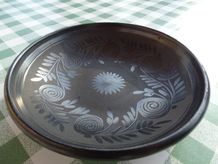 Black pottery from Nådudvar
Black pottery from Nådudvar
Next morning we took even worse roads than normal for this part of the country towards Nádudvar where a man called Mr Fazekas makes black pottery. He explained that the pots are not glazed but are fired twice; the second time at a much higher temperature which excludes all the oxygen and makes the pots black. They are very nice objects and quite rare.
Moving on similar quality roads we arrived at Hortobágy. This is the largest protected area in Hungary and the “largest semi-natural grassland in Europe”. Hortobágy is a steppe, a grassy plain with Hungarian Grey cattle, racka sheep, water buffalo, and wild horses tended by herdsmen. It provides habitat for various species including 342 species of birds.
Moving on similar quality roads we arrived at Hortobágy. This is the largest protected area in Hungary and the “largest semi-natural grassland in Europe”. Hortobágy is a steppe, a grassy plain with Hungarian Grey cattle, racka sheep, water buffalo, and wild horses tended by herdsmen. It provides habitat for various species including 342 species of birds.
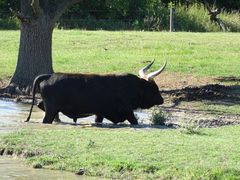 One of the "reconstructed" aurochs.
One of the "reconstructed" aurochs.
To be honest Hortobágy village consists of little other than a tourist information centre and an expensive restaurant. The interesting things happen in the surrounding area. After setting up camp, alone, in the Hortobágy Campsite we went for a walk around the village. We avoided the expensive restaurant and found a pizza parlour and it was very good indeed.
In the evening we bought a ticket from one of the small museums and enjoyed a guided bus ride across the very flat countryside to a local-wildlife zoo. There we saw Golden Jackal, Wild Cats, and two rather large “cows”. Almost black and with very large horns they looked formidable. We were told they had been “reconstructed”, which apparently is a breeding programme of Taurus cattle in an attempt to breed back the “aurochs”.
In the evening we bought a ticket from one of the small museums and enjoyed a guided bus ride across the very flat countryside to a local-wildlife zoo. There we saw Golden Jackal, Wild Cats, and two rather large “cows”. Almost black and with very large horns they looked formidable. We were told they had been “reconstructed”, which apparently is a breeding programme of Taurus cattle in an attempt to breed back the “aurochs”.
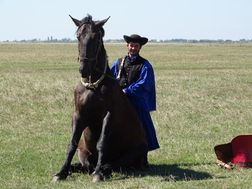 A Hungarian cowboy.
A Hungarian cowboy.
After a very peaceful sleep in the campsite we made our way to a stud farm where we could take a carriage ride onto the extensive grasslands. As we had about one hour to wait we meandered round the stables and examined the famous Lipicai horses. We are not horsey people but they certainly looked good.
Once the carriages arrived we climbed aboard and were soon bouncing along the dirt tracks. First stop was to look at some Racka sheep which have corkscrew horns and Rastafarian style wool. They were housed in barns where the thatched roof comes down to the ground.
After a few oohs and aahs we remounted and made our way to some horsemen who put on a small display. First riding around us while cracking their whips. Then, making the horse lie down, they stood on its shoulders and did a bit more whip cracking. Amazingly the horses did not mind the noise. Afterwards the horses sat up rather like dogs before standing. Then the fun bit watching some people attempt to climb aboard the very patient horses.
Once the carriages arrived we climbed aboard and were soon bouncing along the dirt tracks. First stop was to look at some Racka sheep which have corkscrew horns and Rastafarian style wool. They were housed in barns where the thatched roof comes down to the ground.
After a few oohs and aahs we remounted and made our way to some horsemen who put on a small display. First riding around us while cracking their whips. Then, making the horse lie down, they stood on its shoulders and did a bit more whip cracking. Amazingly the horses did not mind the noise. Afterwards the horses sat up rather like dogs before standing. Then the fun bit watching some people attempt to climb aboard the very patient horses.
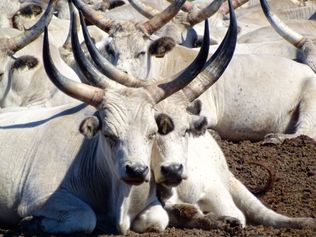 Hungarian Grey Cattle.
Hungarian Grey Cattle.
Back aboard the carriages we trundled about another kilometer to see some Grey Cattle. These cattle were described as tall and slender. They are not. They are damned big chunky beast with enormous horns and are not to be messed with. The Grey Cattle are native to Hungary and semi-wild. In 1975 there were only 300 grey cows left in the country but common sense has prevailed and numbers have increased. These herds serve as gene banks, due to their reported resistance to cattle diseases which affect more highly bred cattle types.
Probably the most laid back animals on the plain are the water buffalo. The pictures tell all. But we were not allowed off the carriages. Maybe they don’t like visitors at bath time.
After our little excursion across the puszta we turned back to Almadi direction. The roads were still bad. We had to drive to the centre of Szolnok so that we could retrace our steps on the opposite side of the Tisza river. Ian has always liked to translate place names literally. The next village was Csataszög. Literally translates as “battle nail”. Lots of place and street names were changed after the fall of Communism. The local villagers clearly still enjoyed having a main street called Szebb Élet út, or “Better Life Road”. Sadly the roads are not getting any better.
Probably the most laid back animals on the plain are the water buffalo. The pictures tell all. But we were not allowed off the carriages. Maybe they don’t like visitors at bath time.
After our little excursion across the puszta we turned back to Almadi direction. The roads were still bad. We had to drive to the centre of Szolnok so that we could retrace our steps on the opposite side of the Tisza river. Ian has always liked to translate place names literally. The next village was Csataszög. Literally translates as “battle nail”. Lots of place and street names were changed after the fall of Communism. The local villagers clearly still enjoyed having a main street called Szebb Élet út, or “Better Life Road”. Sadly the roads are not getting any better.
The following village was Nagykörü which is where one of Judit’s many cousins has a house. We had a lovely evening on the terrace drinking, eating and story telling. But the evening was soon gone and in the morning we headed back to Almadi. The five hour journey could have been four hours if the roads had been repaired.
Cyclists in Hungary; and maybe elsewhere
In the past Hungary was pretty good regarding roads. But now the government are pandering to the Cycling Mafia and building cycle paths instead of repairing roads. They claim to have over 2,000 kilometers of cycle track. You can cycle from Vienna to Budapest, all the way round Lake Balaton and even Budapest to Krakow. The government (that means the people who get grants from the EU and give the work to a family friend) claim to have 200 kilometers of cycle paths in Budapest alone. However, a cycle path mostly means a yellow line marking a lane down one side of a pavement or road and stealing pedestrian or car space. They can even cycle the wrong way down a one way street.
The cycle mafia are a sad lot and seem to think they are the only ones who can save the world. But they often do this by riding on the footpath, across zebra crossing, ignore traffic signal and so on. A purpose built cycle path now parallels the Danube near Batthyány Tér in Budapest. Cyclists often do not use it but speed along the footpath scaring pedestrians. One got a surprise when Ian refused to move and pointed to the cycle path only 2 meters away. The idiot was even more surprised when, after attempting to push Ian out of the way, he ended up on the floor in a tangle of spokes and dayglow Lycra.
We notice that cyclists in the UK now seem to carry cameras so they can record their accidents. Are they wanting accidents to happen?
We along with millions of others have developed a loathing for the self righteous Lycra Louts who take up too much space on roads and use up far too much oxygen. If they want to be really healthy, stop riding a bike and walk. Cycling is exercise cheating.
In the past Hungary was pretty good regarding roads. But now the government are pandering to the Cycling Mafia and building cycle paths instead of repairing roads. They claim to have over 2,000 kilometers of cycle track. You can cycle from Vienna to Budapest, all the way round Lake Balaton and even Budapest to Krakow. The government (that means the people who get grants from the EU and give the work to a family friend) claim to have 200 kilometers of cycle paths in Budapest alone. However, a cycle path mostly means a yellow line marking a lane down one side of a pavement or road and stealing pedestrian or car space. They can even cycle the wrong way down a one way street.
The cycle mafia are a sad lot and seem to think they are the only ones who can save the world. But they often do this by riding on the footpath, across zebra crossing, ignore traffic signal and so on. A purpose built cycle path now parallels the Danube near Batthyány Tér in Budapest. Cyclists often do not use it but speed along the footpath scaring pedestrians. One got a surprise when Ian refused to move and pointed to the cycle path only 2 meters away. The idiot was even more surprised when, after attempting to push Ian out of the way, he ended up on the floor in a tangle of spokes and dayglow Lycra.
We notice that cyclists in the UK now seem to carry cameras so they can record their accidents. Are they wanting accidents to happen?
We along with millions of others have developed a loathing for the self righteous Lycra Louts who take up too much space on roads and use up far too much oxygen. If they want to be really healthy, stop riding a bike and walk. Cycling is exercise cheating.
 Jókai Bableves
Jókai Bableves
Food in Hungary
In Hungary we have time to cook... so we do. Judit prepared various Hungarian specialities.
There is a lot to choose from. Traditional Hungarian food goes well beyond classic favourites such as "goulash." While Hungarian cuisine has Austrian, Slavic and Turkish influences (among others) the foods that make up Hungarian gastronomy form a long list.
Start with Langos which is a deep fried dough snack smothered in sour cream and cheese. Perfect for a nibble while sunbathing at the side of Lake Balaton.
We must, of course, mention Gulyás (goulash) which is a hearty soup with paprika, onion and beef cubes stewed with vegetables in a big cauldron. It is not a stew.
There are hundreds of soups in the Hungarian cookery book. Ian’s favourite is Jókai-bableves: a hearty bean soup, often served with pork knuckle, flavoured with vinegar and sour cream. It's named after 19th century Hungarian novelist Jókai Mór, and amazingly, not because he invented it, but just because he really, really liked it.
In Hungary we have time to cook... so we do. Judit prepared various Hungarian specialities.
There is a lot to choose from. Traditional Hungarian food goes well beyond classic favourites such as "goulash." While Hungarian cuisine has Austrian, Slavic and Turkish influences (among others) the foods that make up Hungarian gastronomy form a long list.
Start with Langos which is a deep fried dough snack smothered in sour cream and cheese. Perfect for a nibble while sunbathing at the side of Lake Balaton.
We must, of course, mention Gulyás (goulash) which is a hearty soup with paprika, onion and beef cubes stewed with vegetables in a big cauldron. It is not a stew.
There are hundreds of soups in the Hungarian cookery book. Ian’s favourite is Jókai-bableves: a hearty bean soup, often served with pork knuckle, flavoured with vinegar and sour cream. It's named after 19th century Hungarian novelist Jókai Mór, and amazingly, not because he invented it, but just because he really, really liked it.
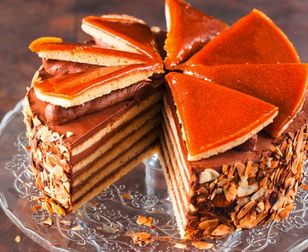 Dobos Torta
Dobos Torta
Pörkölt is a rich meat stew usually cooked outside.
Then there is Kürtőskalács which is a Transylvanian sweet spiral pull-apart bread that is baked outdoors over charcoal. The dough is wrapped around a wooden roller making a tube.
There are cakes such as Dobos Torta, a chocolate buttercream-layered sponge cake, topped with crystallized caramel and covered on the edges with nuts.
Winter is time for Töltött Káposzta (stuffed cabbage). This is large leaves of cabbage, stuffed with meat and rice, which are cooked and then smothered with sour cream. It’s the ultimate Hungarian comfort food. Plus, the cabbage in Hungary is often pickled, offering a deliciously tangy component to this rich, savory dish.
Wine! Hungarian wines are very tasty but badly marketed. Top of the list are Tokaji wines. One French Emperor said they were the king of wines and the wine of kings. While it is only one of several types of wine produced in Tokaj, Aszú is the penultimate variation. Aszú Eszencia, is one of the sweetest and most exclusive wines in the world.
Then there is Kürtőskalács which is a Transylvanian sweet spiral pull-apart bread that is baked outdoors over charcoal. The dough is wrapped around a wooden roller making a tube.
There are cakes such as Dobos Torta, a chocolate buttercream-layered sponge cake, topped with crystallized caramel and covered on the edges with nuts.
Winter is time for Töltött Káposzta (stuffed cabbage). This is large leaves of cabbage, stuffed with meat and rice, which are cooked and then smothered with sour cream. It’s the ultimate Hungarian comfort food. Plus, the cabbage in Hungary is often pickled, offering a deliciously tangy component to this rich, savory dish.
Wine! Hungarian wines are very tasty but badly marketed. Top of the list are Tokaji wines. One French Emperor said they were the king of wines and the wine of kings. While it is only one of several types of wine produced in Tokaj, Aszú is the penultimate variation. Aszú Eszencia, is one of the sweetest and most exclusive wines in the world.
 Bejgli
Bejgli
Another comfort food is Paprikás Csirke which is chicken in a creamy, paprika sauce, often served with (surprise!) sour cream. It’s hot, spicy, meaty goodness, and is generally accompanied by a delicious side of dumplings or pasta.
Pogácsa are small, bite-sized savoury scones and often topped with cheese. Usually one of the first things to be served at dinner parties and get-togethers, pogácsa are a delicious and simple snack food of which it is impossible to eat just one.
Körözött is a spread made of cottage cheese, spices (often paprika), and onions. It’s like the hummus of Hungary.
Christmas would not be the same without Bejgli. It is a Swiss roll shaped log containing a sweet walnut or poppyseed filling.
Ian’s favourite is Rakott Krumpli which is layers of sliced potatoes cooked in its skin, sliced hard boiled eggs, sausage, cheese and of course sour cream, all baked together in the oven.
For dessert try Somlói Galuska. It is made of three different types of sponge cake (plain, walnut, and chocolate), raisins, and walnuts, drizzled with dark chocolate rum sauce and topped with whipped cream. Think trifle without the custard.
Pogácsa are small, bite-sized savoury scones and often topped with cheese. Usually one of the first things to be served at dinner parties and get-togethers, pogácsa are a delicious and simple snack food of which it is impossible to eat just one.
Körözött is a spread made of cottage cheese, spices (often paprika), and onions. It’s like the hummus of Hungary.
Christmas would not be the same without Bejgli. It is a Swiss roll shaped log containing a sweet walnut or poppyseed filling.
Ian’s favourite is Rakott Krumpli which is layers of sliced potatoes cooked in its skin, sliced hard boiled eggs, sausage, cheese and of course sour cream, all baked together in the oven.
For dessert try Somlói Galuska. It is made of three different types of sponge cake (plain, walnut, and chocolate), raisins, and walnuts, drizzled with dark chocolate rum sauce and topped with whipped cream. Think trifle without the custard.
 Some Hungarian sausages.
Some Hungarian sausages.
Sausages come in many forms in Hungary. Two of the most common are Hurka and Kolbász... hurka is generally boiled or baked in the oven and kolbász is generally smoked. While both can easily be eaten alone or simply with potatoes and peppers, hurka and kolbász are also present in many more complicated Hungarian dishes, making them incredibly versatile meats.
In Autumn housewives can be seen shopping for sacks of paprika and tomatoes. They are to be preserved for the winter, but they are also eaten fresh of course. Lecsó is a paprika vegetable stew of onions, tomatoes, and peppers, with variations including sausage and egg. It is hearty and relatively healthy compared to most Hungarian fare.
Everybody knows that Hungarians like paprika. It is a Hungarian red pepper eaten raw or dried into powder or paste. Paprika ranges in taste from sweet and wonderfully red to fiery... so take care.
You may have noticed that Hungarians do not understand vegetarians. Even a vegetarian stew such as Fözelék may be made with meat stock.
During a visit to Budapest in 1993 Prince Philip, said to a tourist, “you can’t have been here that long - you haven’t got a pot belly.” The above shows why.
Ian made muffins (not American buns) and oxtail stew, plus few curries. We both enjoyed Indian lentil nibbles and Ian enjoyed nibbling Nigella’s cheesy biscuits. Judit made a superb Moussaka based on Rick Stein’s recipe from his series “Venice to Istanbul”.
But it does put the pounds on.
In Autumn housewives can be seen shopping for sacks of paprika and tomatoes. They are to be preserved for the winter, but they are also eaten fresh of course. Lecsó is a paprika vegetable stew of onions, tomatoes, and peppers, with variations including sausage and egg. It is hearty and relatively healthy compared to most Hungarian fare.
Everybody knows that Hungarians like paprika. It is a Hungarian red pepper eaten raw or dried into powder or paste. Paprika ranges in taste from sweet and wonderfully red to fiery... so take care.
You may have noticed that Hungarians do not understand vegetarians. Even a vegetarian stew such as Fözelék may be made with meat stock.
During a visit to Budapest in 1993 Prince Philip, said to a tourist, “you can’t have been here that long - you haven’t got a pot belly.” The above shows why.
Ian made muffins (not American buns) and oxtail stew, plus few curries. We both enjoyed Indian lentil nibbles and Ian enjoyed nibbling Nigella’s cheesy biscuits. Judit made a superb Moussaka based on Rick Stein’s recipe from his series “Venice to Istanbul”.
But it does put the pounds on.
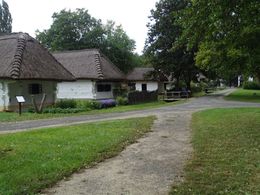 Part of the lovely village museum at Zalaegerszeg.
Part of the lovely village museum at Zalaegerszeg.
On the move again 30 September 2016
What a good feeling to be moving again. It’s an adventure when you don’t really know what you will find. Our first find was at Zalaegerszeg where there is a reconstructed village. It’s an open air museum showing the houses and farms as they have been for hundreds of years.
Magyarország Zalaegerszeg Falumúzeum N 46° 50.986', E 16° 49.693'
The houses really do appear to be a complete village in very lovely surroundings. As a bonus, nicely separated from the village, there is a museum of the Hungarian Oil Industry. It’s very well presented. In fact the two together make for a very interesting couple of hours.
What a good feeling to be moving again. It’s an adventure when you don’t really know what you will find. Our first find was at Zalaegerszeg where there is a reconstructed village. It’s an open air museum showing the houses and farms as they have been for hundreds of years.
Magyarország Zalaegerszeg Falumúzeum N 46° 50.986', E 16° 49.693'
The houses really do appear to be a complete village in very lovely surroundings. As a bonus, nicely separated from the village, there is a museum of the Hungarian Oil Industry. It’s very well presented. In fact the two together make for a very interesting couple of hours.
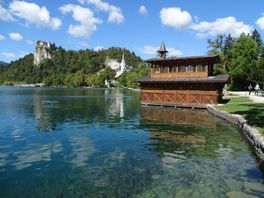 Lake Bled, Slovenia.
Lake Bled, Slovenia.
Slovenia
Only a few kilometers away was Camp Borostyan. Borostyan is the Hungarian word for amber. Historians tell us that the local village was on the “Amber Route”.
The camp is well situated next to a dam. However the new Austrian owners have put the prices up and now the campers seem to be all from nearby Austria. We stayed just the one night.
In the morning we entered Slovenia with no border control and then had a fairly long drive to Bled. We’ve been here before and found the area very beautiful.
After a restful night we took the little tourist road train into the town. It goes around the lake and the views are excellent. Once in town after a stroll we found the cafe that is said to have invented a cream cake with custard filling and layers of puff pastry on top and bottom. We are sure that the Belgians and the Dutch will argue about that with their own “Tompoes”. And the Croats with Kremsnita, the Italians with mille foglie, the Hungarians with Krémes, the French with “Napoleons” and of course Yorkshire with their superior Custard Slice... yummy.
Only a few kilometers away was Camp Borostyan. Borostyan is the Hungarian word for amber. Historians tell us that the local village was on the “Amber Route”.
The camp is well situated next to a dam. However the new Austrian owners have put the prices up and now the campers seem to be all from nearby Austria. We stayed just the one night.
In the morning we entered Slovenia with no border control and then had a fairly long drive to Bled. We’ve been here before and found the area very beautiful.
After a restful night we took the little tourist road train into the town. It goes around the lake and the views are excellent. Once in town after a stroll we found the cafe that is said to have invented a cream cake with custard filling and layers of puff pastry on top and bottom. We are sure that the Belgians and the Dutch will argue about that with their own “Tompoes”. And the Croats with Kremsnita, the Italians with mille foglie, the Hungarians with Krémes, the French with “Napoleons” and of course Yorkshire with their superior Custard Slice... yummy.
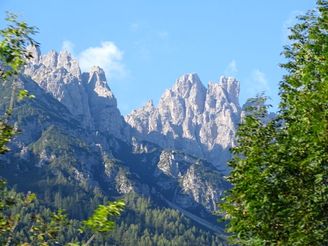 Fantastic views in the Dolomites.
Fantastic views in the Dolomites.
Dolomites
Although the Bled area is mountainous we now set off into the Italian Dolomites for real. The roads are in good condition and the views are superb. However the driver is kept very busy with all the bends and oncoming vehicles. Today the routes over the mountains were very busy with motorcyclists trying to beat the world record. Some of them were very fast indeed. In the evening we stopped at a free sosta in Forni di Sopra.
Next day, more of the same views, bends and motorbikes until we found a sosta at Ponte di Legno. In an effort to perform a sixteen-point turn Ian managed to find a wall with the bumper bar. It did its job and saved the corner of the motorhome. Next day we found a lovely camp at the North end of Lake Como called Campeggio La Riva. Very well appointed in lovely surroundings, but expensive. We guessed that rich Swiss came here for their breaks.
In the morning we had a stroll along the river to the nearby village of Sorico. Being a Sunday everything was closed except for a nice snack bar on the waterside. There we enjoyed an Aperelo Sprize and watched the world go by. Very relaxing.
Although the Bled area is mountainous we now set off into the Italian Dolomites for real. The roads are in good condition and the views are superb. However the driver is kept very busy with all the bends and oncoming vehicles. Today the routes over the mountains were very busy with motorcyclists trying to beat the world record. Some of them were very fast indeed. In the evening we stopped at a free sosta in Forni di Sopra.
Next day, more of the same views, bends and motorbikes until we found a sosta at Ponte di Legno. In an effort to perform a sixteen-point turn Ian managed to find a wall with the bumper bar. It did its job and saved the corner of the motorhome. Next day we found a lovely camp at the North end of Lake Como called Campeggio La Riva. Very well appointed in lovely surroundings, but expensive. We guessed that rich Swiss came here for their breaks.
In the morning we had a stroll along the river to the nearby village of Sorico. Being a Sunday everything was closed except for a nice snack bar on the waterside. There we enjoyed an Aperelo Sprize and watched the world go by. Very relaxing.
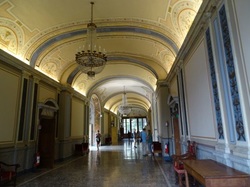 Villa Carlotta.
Villa Carlotta.
Lake Como
However the next day was far from relaxing for Ian. Judit wanted to visit Villa Carlotti. The roads were very busy and the lakeside road is not very wide. At one point a motorhome came around a corner too quickly and our wing mirrors crashed together. Luckily no major damage. On the driver’s right, going south there is a wall and it is quite nerve wracking at times.
The next problem was parking. Ian finally managed to park next to a British coach. Judit made a mad dash around the villa while Ian stayed with Bessy in case he had to move her. Lake Como... nice place but awful traffic.
In the hope of a quiet mountain cafe Ian headed back north to Menaggio and took the mountain road westward to Porlezza. There was no cafe... just traffic.
Once in Switzerland we found a Lidl in Lugano and then made our way north. At last we had our morning coffee in a motorway car park.
However the next day was far from relaxing for Ian. Judit wanted to visit Villa Carlotti. The roads were very busy and the lakeside road is not very wide. At one point a motorhome came around a corner too quickly and our wing mirrors crashed together. Luckily no major damage. On the driver’s right, going south there is a wall and it is quite nerve wracking at times.
The next problem was parking. Ian finally managed to park next to a British coach. Judit made a mad dash around the villa while Ian stayed with Bessy in case he had to move her. Lake Como... nice place but awful traffic.
In the hope of a quiet mountain cafe Ian headed back north to Menaggio and took the mountain road westward to Porlezza. There was no cafe... just traffic.
Once in Switzerland we found a Lidl in Lugano and then made our way north. At last we had our morning coffee in a motorway car park.
After Basel we entered France. Then a relatively short drive to Ferette where we have stopped before. We spent the night alone in the aire and in the morning drove down to the village and had a good wander around. Nice place with a castle on a hill. Also a nice coffee shop with delicious cakes. Our next stop on the journey home was to the world’s best supermarket... E. Leclerc. The one we love is near Altkirch. Yes, we know supermarkets are normally boring, but this one has very wide aisles, is very clean, it has a wonderful bakers, a butchery department to leave you drooling and is staffed by people who want to help.
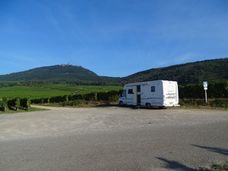 Saint-Hippolyte Night Stop
Saint-Hippolyte Night Stop
Saint-Hippolyte 27 September 2016
The road north took us through the Alsace region, famous for wine and good solid fodder with a French touch. We found a very simple parking place which we had ignored in previous years. It’s nothing more than a junction of dirt roads in the vineyards but it has magnificent views of the Château du Haut-Koenigsbourg.
Now is the time for harvesting grapes and all afternoon we were given a cheery greeting by the locals as they drove their tractors and trailers full of freshly picked grapes to the press.
The road north took us through the Alsace region, famous for wine and good solid fodder with a French touch. We found a very simple parking place which we had ignored in previous years. It’s nothing more than a junction of dirt roads in the vineyards but it has magnificent views of the Château du Haut-Koenigsbourg.
Now is the time for harvesting grapes and all afternoon we were given a cheery greeting by the locals as they drove their tractors and trailers full of freshly picked grapes to the press.
 Judit playing with the castle cannon.
Judit playing with the castle cannon.
It was an easy decision in the morning to drive up the hill and have a look at the castle. According to Wikipedia “it is situated in a strategic location on a rocky spur overlooking the Upper Rhine Plain; as a result it was used by successive powers from the Middle Ages until the Thirty Years' War when it was abandoned. From 1900 to 1908 it was rebuilt at the behest of the German emperor Wilhelm II. Today it is a major tourist site, attracting more than 500,000 visitors a year.”
Once inside it was easy to see why it gets so many visitors. The restoration is excellent and the views would have been superb if the lowland was not covered in mist. Well worth a visit on your travels. (N 48° 14.963', E 7° 20.774').
Our SatNav was set up to avoid toll roads so we were surprised when we arrived at a tunnel near Sainte-Marie-aux-Mines and had to pay €9.40 for a relatively short passage.
Once inside it was easy to see why it gets so many visitors. The restoration is excellent and the views would have been superb if the lowland was not covered in mist. Well worth a visit on your travels. (N 48° 14.963', E 7° 20.774').
Our SatNav was set up to avoid toll roads so we were surprised when we arrived at a tunnel near Sainte-Marie-aux-Mines and had to pay €9.40 for a relatively short passage.
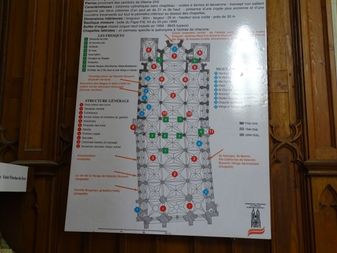 Plan of the "bent basillica".
Plan of the "bent basillica".
Saint Nic 28 September 2016
But never mind, we pointed Bessy towards Nancy but stopped just short at Saint-Nicolas-de-Port. The aire was nothing to shout home about from a technology point of view, but it was in a park with lots of space and shade next to a river and within walking distance of the town.
Near the entrance is a “hospital” for sick storks. This seems to attract the relatives who congregate on the roof of nearby houses. Now and again we could hear them clacking their beaks.
The town is quite pleasant but we appeared to have arrived at half-day closing. However we found the basilica which has an unusual feature... it has a bend halfway along its length. If you look on Google Earth you would think it was an optical distortion, but it is not.
But never mind, we pointed Bessy towards Nancy but stopped just short at Saint-Nicolas-de-Port. The aire was nothing to shout home about from a technology point of view, but it was in a park with lots of space and shade next to a river and within walking distance of the town.
Near the entrance is a “hospital” for sick storks. This seems to attract the relatives who congregate on the roof of nearby houses. Now and again we could hear them clacking their beaks.
The town is quite pleasant but we appeared to have arrived at half-day closing. However we found the basilica which has an unusual feature... it has a bend halfway along its length. If you look on Google Earth you would think it was an optical distortion, but it is not.
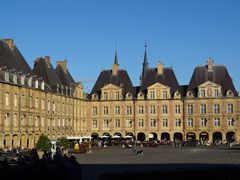 Charleville Square.
Charleville Square.
Next stop was Charleville-Mézières. It is an interesting place to walk around but it has a strange reputation. Puppetry is an important part of the cultural life of Charleville-Mézières. It is even called the “World Capital of Puppetry Arts”. This did not attract Ian who never liked puppets even as a child.
The aire in Charleville-Mézières is next to the camp and we missed that and drove into the aire so it cost us €18.00 for the night. We were “lucky” because the camp closed for the winter the following lunchtime.
We had to drive a short distance into Nancy to buy some diesel before continuing north towards Sedan. Is this where the chair comes from? Today Sedan is known for its castle, that is claimed to be the largest fortified medieval castle in Europe with a total area of 30,000 square metres on seven levels. That may be the case but there are no convenient car parks for motorhomes so we gave it a miss.
The aire in Charleville-Mézières is next to the camp and we missed that and drove into the aire so it cost us €18.00 for the night. We were “lucky” because the camp closed for the winter the following lunchtime.
We had to drive a short distance into Nancy to buy some diesel before continuing north towards Sedan. Is this where the chair comes from? Today Sedan is known for its castle, that is claimed to be the largest fortified medieval castle in Europe with a total area of 30,000 square metres on seven levels. That may be the case but there are no convenient car parks for motorhomes so we gave it a miss.
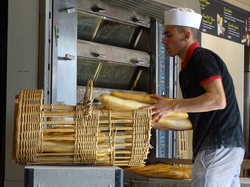 Baker in Cambrai.
Baker in Cambrai.
Arty Farty, 30 September 2016
Our route the following day took us past Le Cateau-Cambresis and Judit was not going to miss the opportunity to visit the Matisse Museum (N 50° 6.360', E 3° 32.461'). At first glance the town looked to be perfect for the arty visit because they have an aire but it was full of French motorhomes. The only option was to park nose in on the main street with the back end sticking out a few inches.
Judit enjoyed the museum and we drove on to Cambrai. We stopped at the “3 Cloches Camp” last year and found it OK. Now it is even better because they have excellent wi-fi around the camp.
Last year we did not look around the town so this time we had a really good meander. Cambrai is a nice town with scruffy roads leading to the centre. There are three tall towers in the town and that’s where the camp’s name came from. The central park had a lovely grotto and the tourist information centre had nice leather Chesterfields to lounge on in a very old timber-framed building.
Our route the following day took us past Le Cateau-Cambresis and Judit was not going to miss the opportunity to visit the Matisse Museum (N 50° 6.360', E 3° 32.461'). At first glance the town looked to be perfect for the arty visit because they have an aire but it was full of French motorhomes. The only option was to park nose in on the main street with the back end sticking out a few inches.
Judit enjoyed the museum and we drove on to Cambrai. We stopped at the “3 Cloches Camp” last year and found it OK. Now it is even better because they have excellent wi-fi around the camp.
Last year we did not look around the town so this time we had a really good meander. Cambrai is a nice town with scruffy roads leading to the centre. There are three tall towers in the town and that’s where the camp’s name came from. The central park had a lovely grotto and the tourist information centre had nice leather Chesterfields to lounge on in a very old timber-framed building.
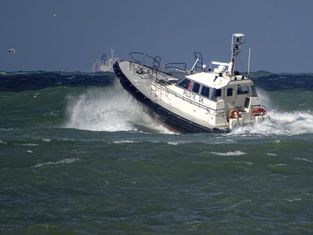 Calais Pilot Boat.
Calais Pilot Boat.
Down to the sea, 2 October 2016
Sunday again. The supermarket we wanted in Grande-Synthe was closed and the filling station only took plastic. We do not trust the system so drove on. It’s not a good idea to let a machine eat your card when you are a long way from home. We drove onwards to Calais, passing the “Jungle” area. The only activity we saw was a large wall being erected at great cost to the British. (Within a month the French removed the Jungle residents, so the building costs were wasted... thank you Mr Hollande, the money could have gone onto my pension).
There was a surprise in store at Calais Aire... the sturdy fortress walls have gone and there is a lot of construction work going on. But the Aire is still usable. After parking we had a good meander along the shore. The sun was shining and the high wind made the skippers of all vessels earn their money. Once again, in the evening, we raided the chip shop for sausage and chips.
Sunday again. The supermarket we wanted in Grande-Synthe was closed and the filling station only took plastic. We do not trust the system so drove on. It’s not a good idea to let a machine eat your card when you are a long way from home. We drove onwards to Calais, passing the “Jungle” area. The only activity we saw was a large wall being erected at great cost to the British. (Within a month the French removed the Jungle residents, so the building costs were wasted... thank you Mr Hollande, the money could have gone onto my pension).
There was a surprise in store at Calais Aire... the sturdy fortress walls have gone and there is a lot of construction work going on. But the Aire is still usable. After parking we had a good meander along the shore. The sun was shining and the high wind made the skippers of all vessels earn their money. Once again, in the evening, we raided the chip shop for sausage and chips.
England and home, 3 October 2016
As our ferry did not leave until around 11-00 we visited some shops in the area and managed to find some cheap diesel before entering the port. As expected we were searched, this time by three very serious and heavily armed French soldiers. Then we were searched again by the British Customs. We have no problem with this. Once we were in our line waiting for departure we were pleased to see French search dogs sniffing their way among the lorries.
With the sun shining and the wind gone we had a very pleasant crossing and soon we were on the M25 heading for home.
As our ferry did not leave until around 11-00 we visited some shops in the area and managed to find some cheap diesel before entering the port. As expected we were searched, this time by three very serious and heavily armed French soldiers. Then we were searched again by the British Customs. We have no problem with this. Once we were in our line waiting for departure we were pleased to see French search dogs sniffing their way among the lorries.
With the sun shining and the wind gone we had a very pleasant crossing and soon we were on the M25 heading for home.
